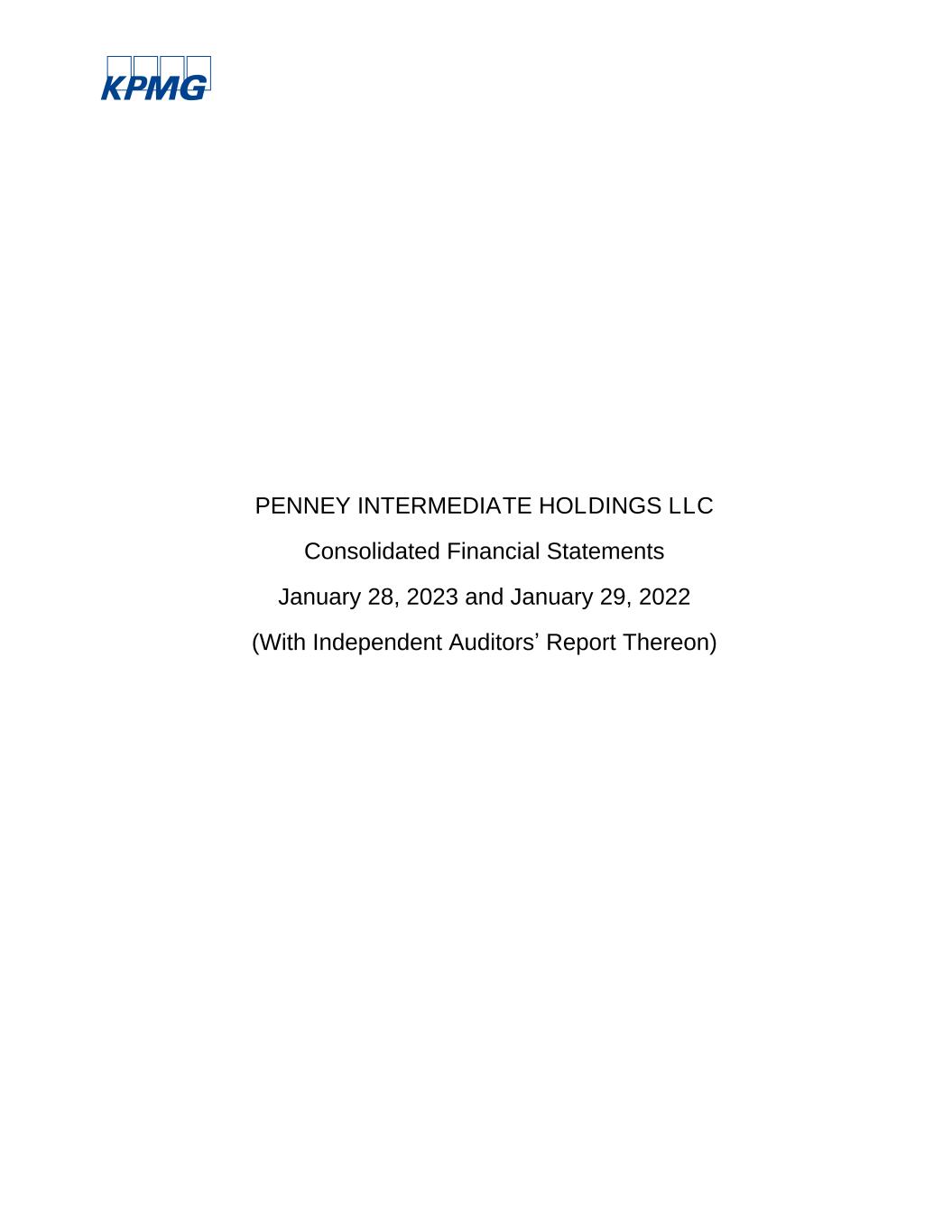
PENNEY INTERMEDIATE HOLDINGS LLC Consolidated Financial Statements January 28, 2023 and January 29, 2022 (With Independent Auditors’ Report Thereon)
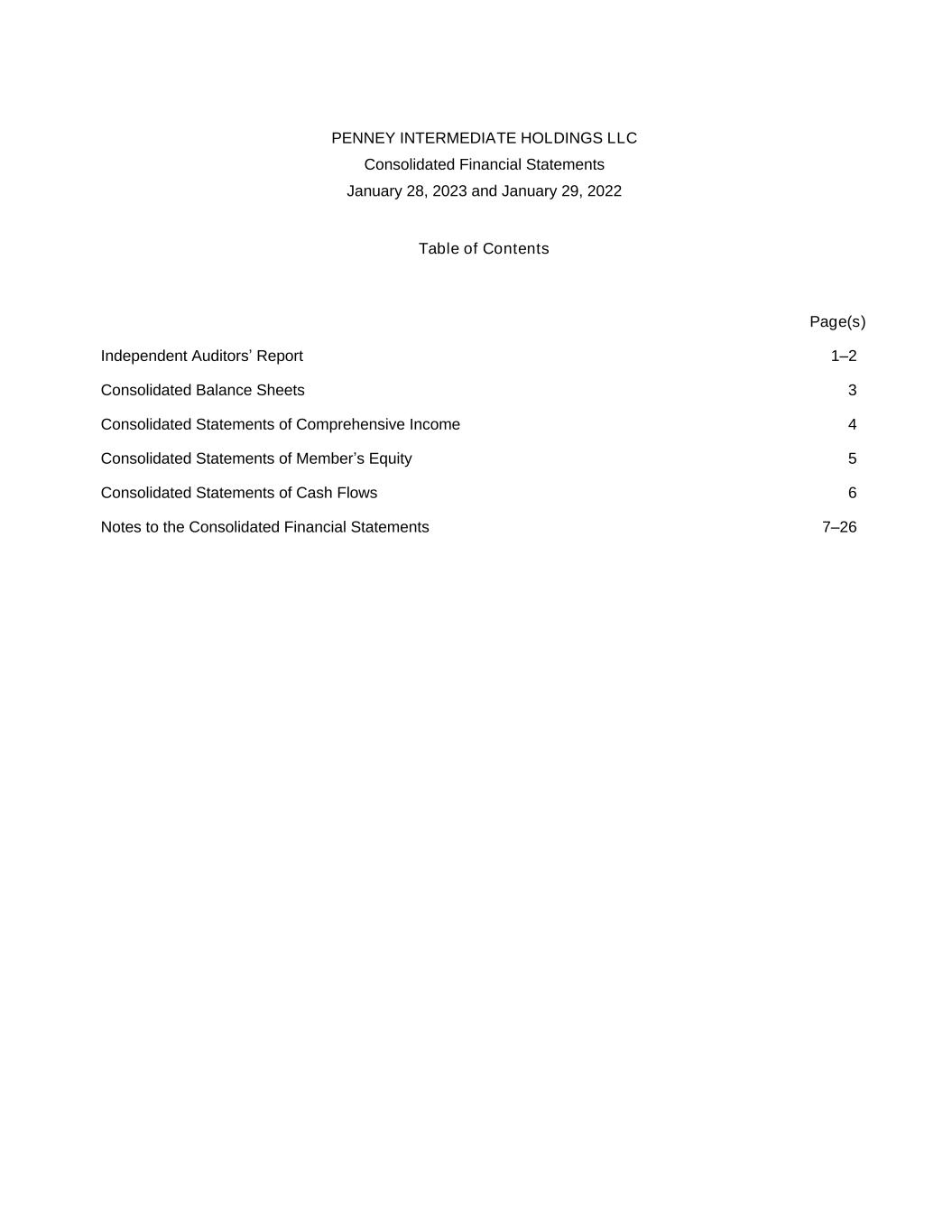
PENNEY INTERMEDIATE HOLDINGS LLC Consolidated Financial Statements January 28, 2023 and January 29, 2022 Table of Contents Page(s) Independent Auditors’ Report 1–2 Consolidated Balance Sheets 3 Consolidated Statements of Comprehensive Income 4 Consolidated Statements of Member’s Equity 5 Consolidated Statements of Cash Flows 6 Notes to the Consolidated Financial Statements 7–26
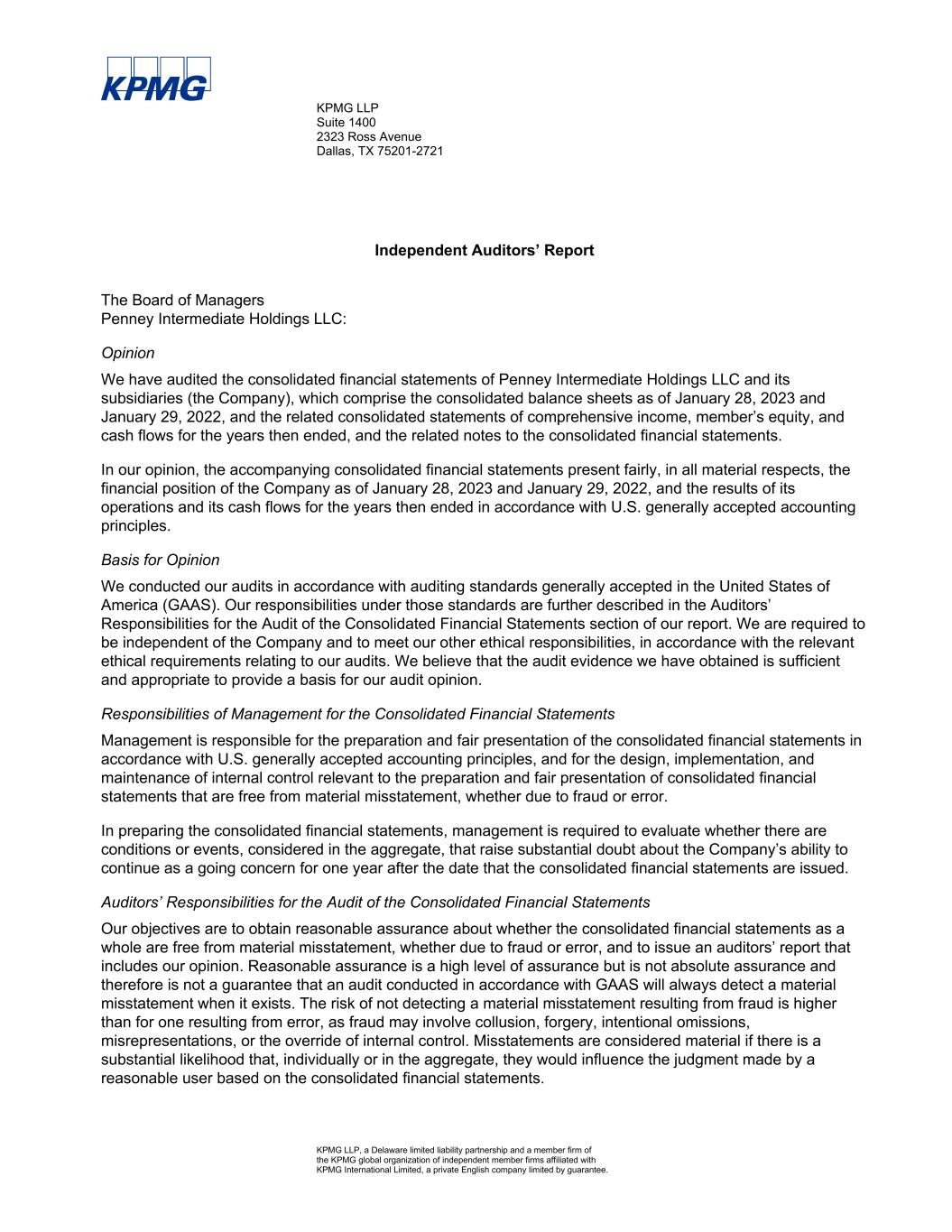
KPMG LLP Suite 1400 2323 Ross Avenue Dallas, TX 75201-2721 KPMG LLP, a Delaware limited liability partnership and a member firm of the KPMG global organization of independent member firms affiliated with KPMG International Limited, a private English company limited by guarantee. Independent Auditors’ Report The Board of Managers Penney Intermediate Holdings LLC: Opinion We have audited the consolidated financial statements of Penney Intermediate Holdings LLC and its subsidiaries (the Company), which comprise the consolidated balance sheets as of January 28, 2023 and January 29, 2022, and the related consolidated statements of comprehensive income, member’s equity, and cash flows for the years then ended, and the related notes to the consolidated financial statements. In our opinion, the accompanying consolidated financial statements present fairly, in all material respects, the financial position of the Company as of January 28, 2023 and January 29, 2022, and the results of its operations and its cash flows for the years then ended in accordance with U.S. generally accepted accounting principles. Basis for Opinion We conducted our audits in accordance with auditing standards generally accepted in the United States of America (GAAS). Our responsibilities under those standards are further described in the Auditors’ Responsibilities for the Audit of the Consolidated Financial Statements section of our report. We are required to be independent of the Company and to meet our other ethical responsibilities, in accordance with the relevant ethical requirements relating to our audits. We believe that the audit evidence we have obtained is sufficient and appropriate to provide a basis for our audit opinion. Responsibilities of Management for the Consolidated Financial Statements Management is responsible for the preparation and fair presentation of the consolidated financial statements in accordance with U.S. generally accepted accounting principles, and for the design, implementation, and maintenance of internal control relevant to the preparation and fair presentation of consolidated financial statements that are free from material misstatement, whether due to fraud or error. In preparing the consolidated financial statements, management is required to evaluate whether there are conditions or events, considered in the aggregate, that raise substantial doubt about the Company’s ability to continue as a going concern for one year after the date that the consolidated financial statements are issued. Auditors’ Responsibilities for the Audit of the Consolidated Financial Statements Our objectives are to obtain reasonable assurance about whether the consolidated financial statements as a whole are free from material misstatement, whether due to fraud or error, and to issue an auditors’ report that includes our opinion. Reasonable assurance is a high level of assurance but is not absolute assurance and therefore is not a guarantee that an audit conducted in accordance with GAAS will always detect a material misstatement when it exists. The risk of not detecting a material misstatement resulting from fraud is higher than for one resulting from error, as fraud may involve collusion, forgery, intentional omissions, misrepresentations, or the override of internal control. Misstatements are considered material if there is a substantial likelihood that, individually or in the aggregate, they would influence the judgment made by a reasonable user based on the consolidated financial statements.
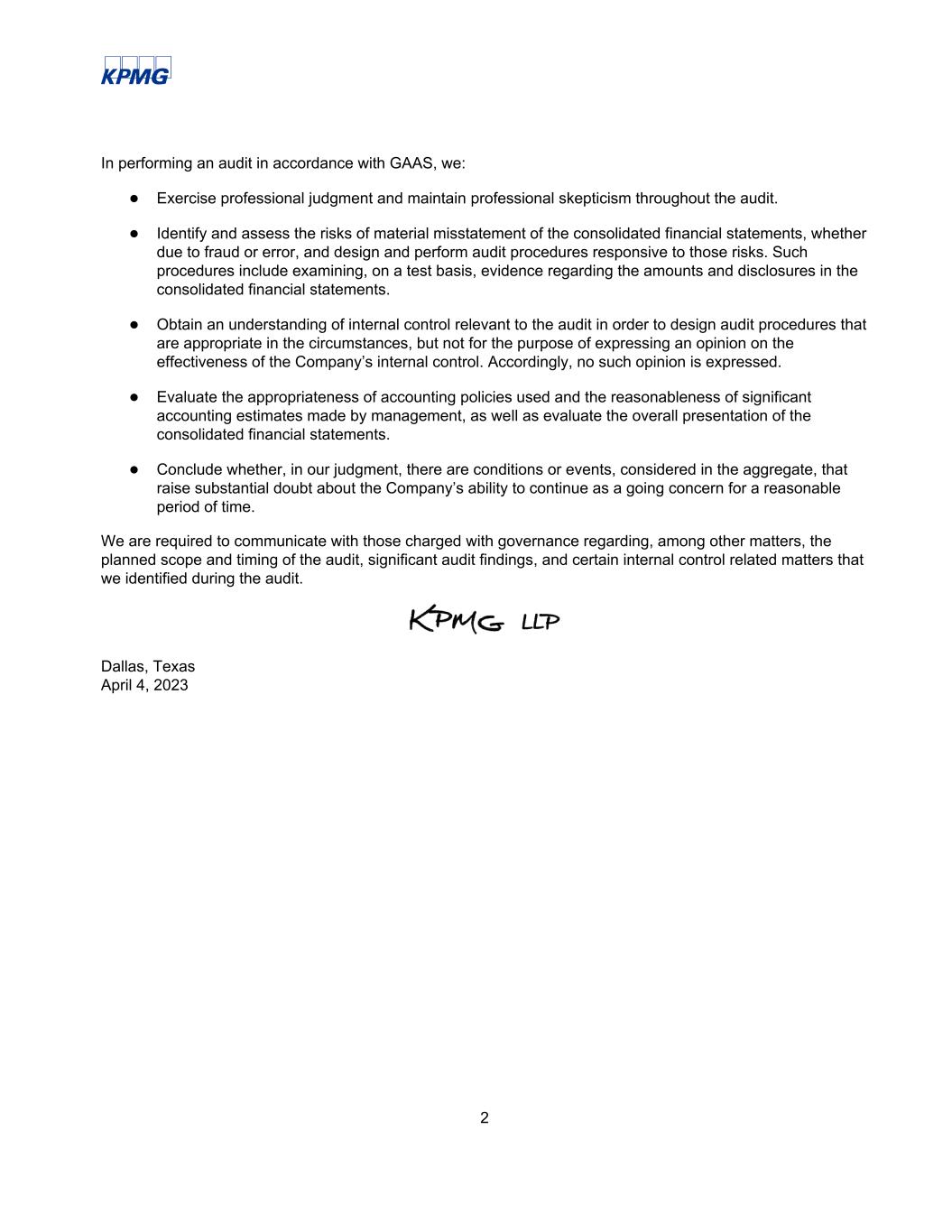
2 In performing an audit in accordance with GAAS, we: ● Exercise professional judgment and maintain professional skepticism throughout the audit. ● Identify and assess the risks of material misstatement of the consolidated financial statements, whether due to fraud or error, and design and perform audit procedures responsive to those risks. Such procedures include examining, on a test basis, evidence regarding the amounts and disclosures in the consolidated financial statements. ● Obtain an understanding of internal control relevant to the audit in order to design audit procedures that are appropriate in the circumstances, but not for the purpose of expressing an opinion on the effectiveness of the Company’s internal control. Accordingly, no such opinion is expressed. ● Evaluate the appropriateness of accounting policies used and the reasonableness of significant accounting estimates made by management, as well as evaluate the overall presentation of the consolidated financial statements. ● Conclude whether, in our judgment, there are conditions or events, considered in the aggregate, that raise substantial doubt about the Company’s ability to continue as a going concern for a reasonable period of time. We are required to communicate with those charged with governance regarding, among other matters, the planned scope and timing of the audit, significant audit findings, and certain internal control related matters that we identified during the audit. Dallas, Texas April 4, 2023
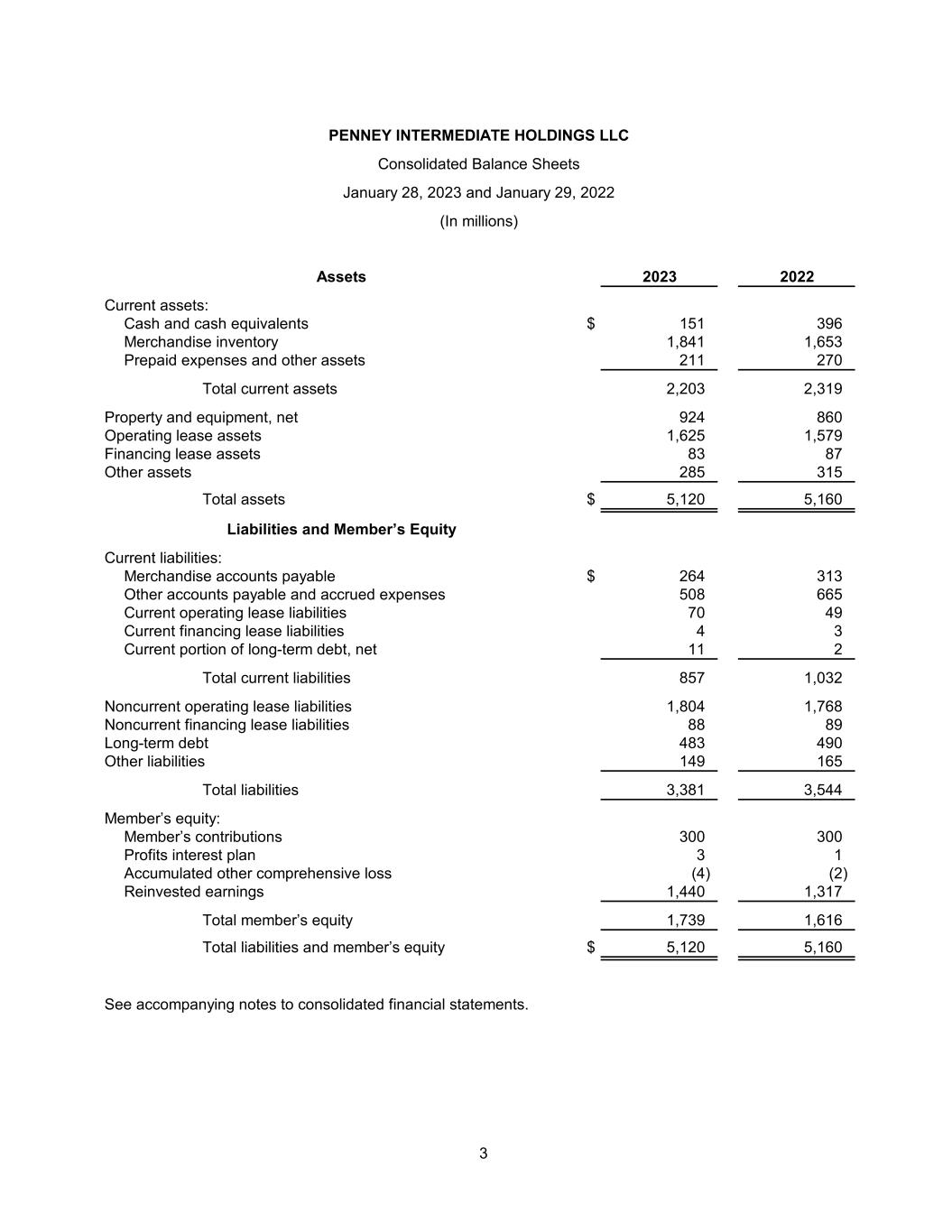
PENNEY INTERMEDIATE HOLDINGS LLC Consolidated Balance Sheets January 28, 2023 and January 29, 2022 (In millions) Assets 2023 2022 Current assets: Cash and cash equivalents $ 151 396 Merchandise inventory 1,841 1,653 Prepaid expenses and other assets 211 270 Total current assets 2,203 2,319 Property and equipment, net 924 860 Operating lease assets 1,625 1,579 Financing lease assets 83 87 Other assets 285 315 Total assets $ 5,120 5,160 Liabilities and Member’s Equity Current liabilities: Merchandise accounts payable $ 264 313 Other accounts payable and accrued expenses 508 665 Current operating lease liabilities 70 49 Current financing lease liabilities 4 3 Current portion of long-term debt, net 11 2 Total current liabilities 857 1,032 Noncurrent operating lease liabilities 1,804 1,768 Noncurrent financing lease liabilities 88 89 Long-term debt 483 490 Other liabilities 149 165 Total liabilities 3,381 3,544 Member’s equity: Member’s contributions 300 300 Profits interest plan 3 1 Accumulated other comprehensive loss (4) (2) Reinvested earnings 1,440 1,317 Total member’s equity 1,739 1,616 Total liabilities and member’s equity $ 5,120 5,160 See accompanying notes to consolidated financial statements. 3
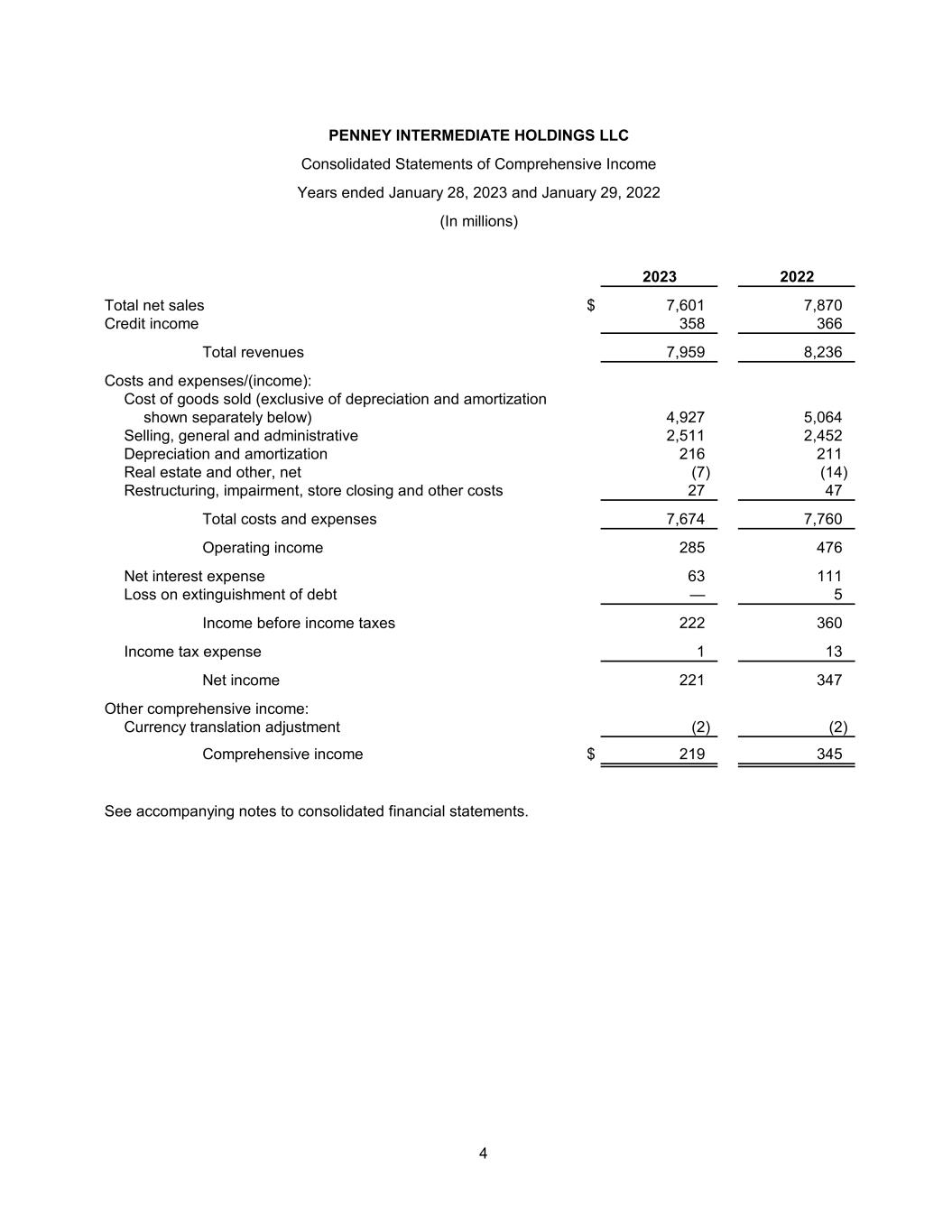
PENNEY INTERMEDIATE HOLDINGS LLC Consolidated Statements of Comprehensive Income Years ended January 28, 2023 and January 29, 2022 (In millions) 2023 2022 Total net sales $ 7,601 7,870 Credit income 358 366 Total revenues 7,959 8,236 Costs and expenses/(income): Cost of goods sold (exclusive of depreciation and amortization shown separately below) 4,927 5,064 Selling, general and administrative 2,511 2,452 Depreciation and amortization 216 211 Real estate and other, net (7) (14) Restructuring, impairment, store closing and other costs 27 47 Total costs and expenses 7,674 7,760 Operating income 285 476 Net interest expense 63 111 Loss on extinguishment of debt — 5 Income before income taxes 222 360 Income tax expense 1 13 Net income 221 347 Other comprehensive income: Currency translation adjustment (2) (2) Comprehensive income $ 219 345 See accompanying notes to consolidated financial statements. 4
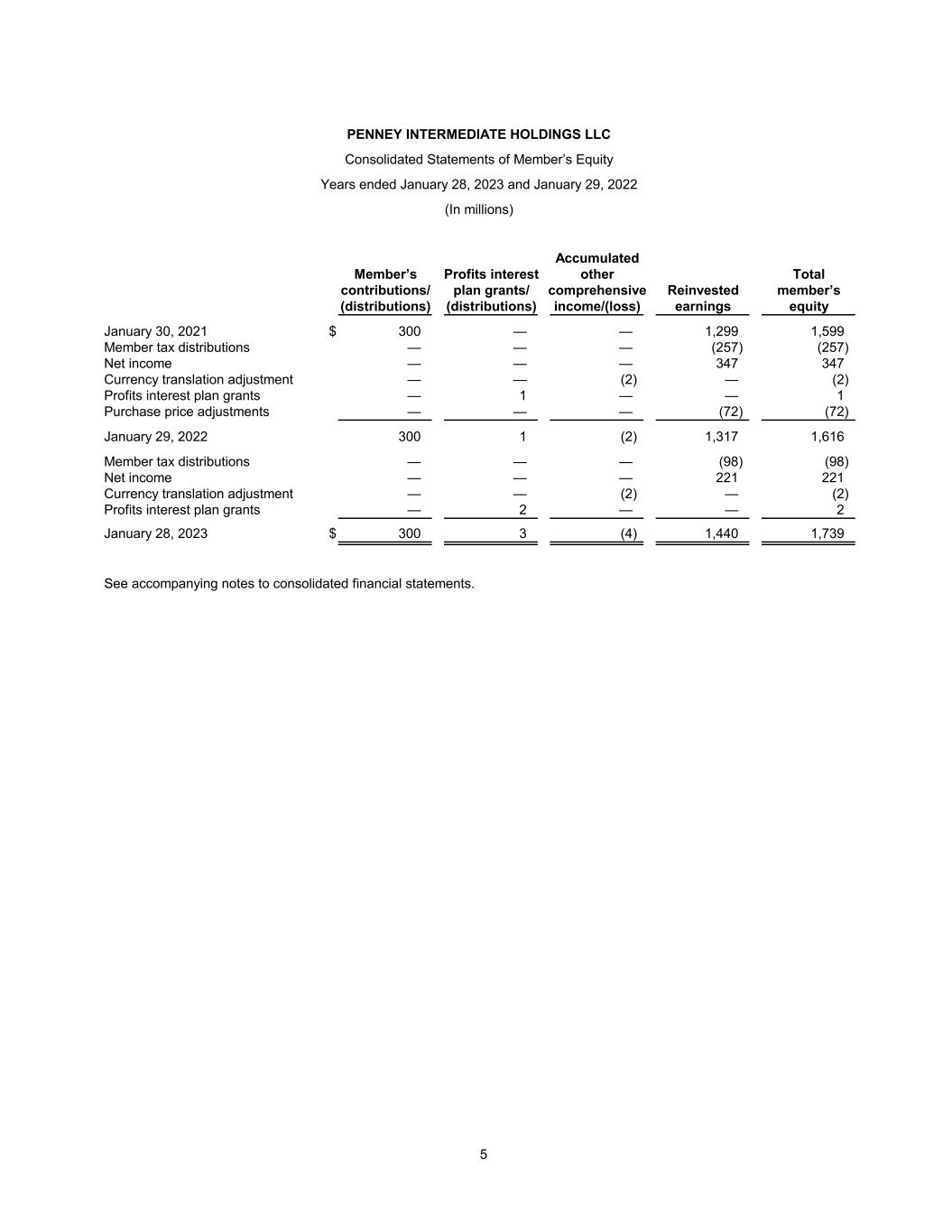
PENNEY INTERMEDIATE HOLDINGS LLC Consolidated Statements of Member’s Equity Years ended January 28, 2023 and January 29, 2022 (In millions) Accumulated Member’s Profits interest other Total contributions/ plan grants/ comprehensive Reinvested member’s (distributions) (distributions) income/(loss) earnings equity January 30, 2021 $ 300 — — 1,299 1,599 Member tax distributions — — — (257) (257) Net income — — — 347 347 Currency translation adjustment — — (2) — (2) Profits interest plan grants — 1 — — 1 Purchase price adjustments — — — (72) (72) January 29, 2022 300 1 (2) 1,317 1,616 Member tax distributions — — — (98) (98) Net income — — — 221 221 Currency translation adjustment — — (2) — (2) Profits interest plan grants — 2 — — 2 January 28, 2023 $ 300 3 (4) 1,440 1,739 See accompanying notes to consolidated financial statements. 5
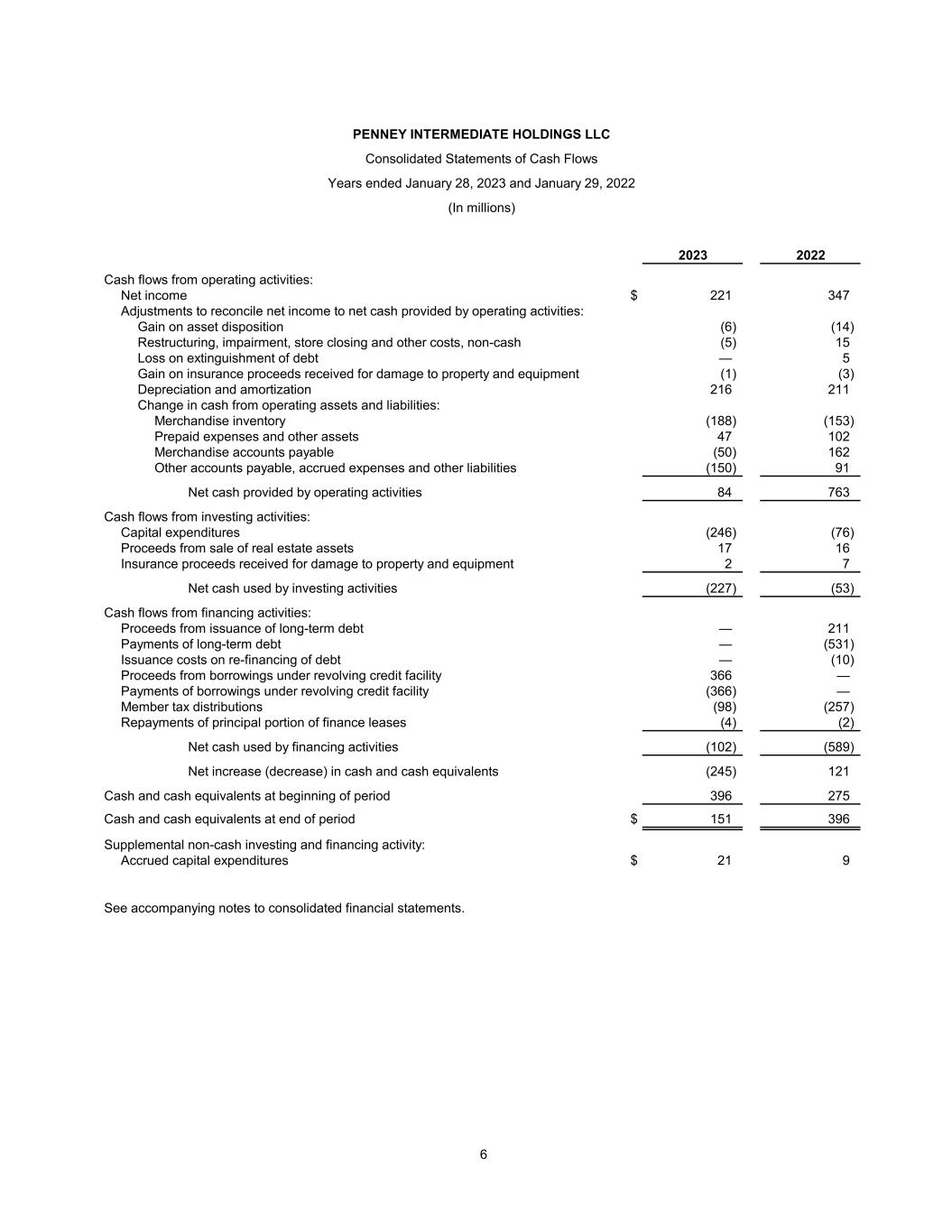
PENNEY INTERMEDIATE HOLDINGS LLC Consolidated Statements of Cash Flows Years ended January 28, 2023 and January 29, 2022 (In millions) 2023 2022 Cash flows from operating activities: Net income $ 221 347 Adjustments to reconcile net income to net cash provided by operating activities: Gain on asset disposition (6) (14) Restructuring, impairment, store closing and other costs, non-cash (5) 15 Loss on extinguishment of debt — 5 Gain on insurance proceeds received for damage to property and equipment (1) (3) Depreciation and amortization 216 211 Change in cash from operating assets and liabilities: Merchandise inventory (188) (153) Prepaid expenses and other assets 47 102 Merchandise accounts payable (50) 162 Other accounts payable, accrued expenses and other liabilities (150) 91 Net cash provided by operating activities 84 763 Cash flows from investing activities: Capital expenditures (246) (76) Proceeds from sale of real estate assets 17 16 Insurance proceeds received for damage to property and equipment 2 7 Net cash used by investing activities (227) (53) Cash flows from financing activities: Proceeds from issuance of long-term debt — 211 Payments of long-term debt — (531) Issuance costs on re-financing of debt — (10) Proceeds from borrowings under revolving credit facility 366 — Payments of borrowings under revolving credit facility (366) — Member tax distributions (98) (257) Repayments of principal portion of finance leases (4) (2) Net cash used by financing activities (102) (589) Net increase (decrease) in cash and cash equivalents (245) 121 Cash and cash equivalents at beginning of period 396 275 Cash and cash equivalents at end of period $ 151 396 Supplemental non-cash investing and financing activity: Accrued capital expenditures $ 21 9 See accompanying notes to consolidated financial statements. 6
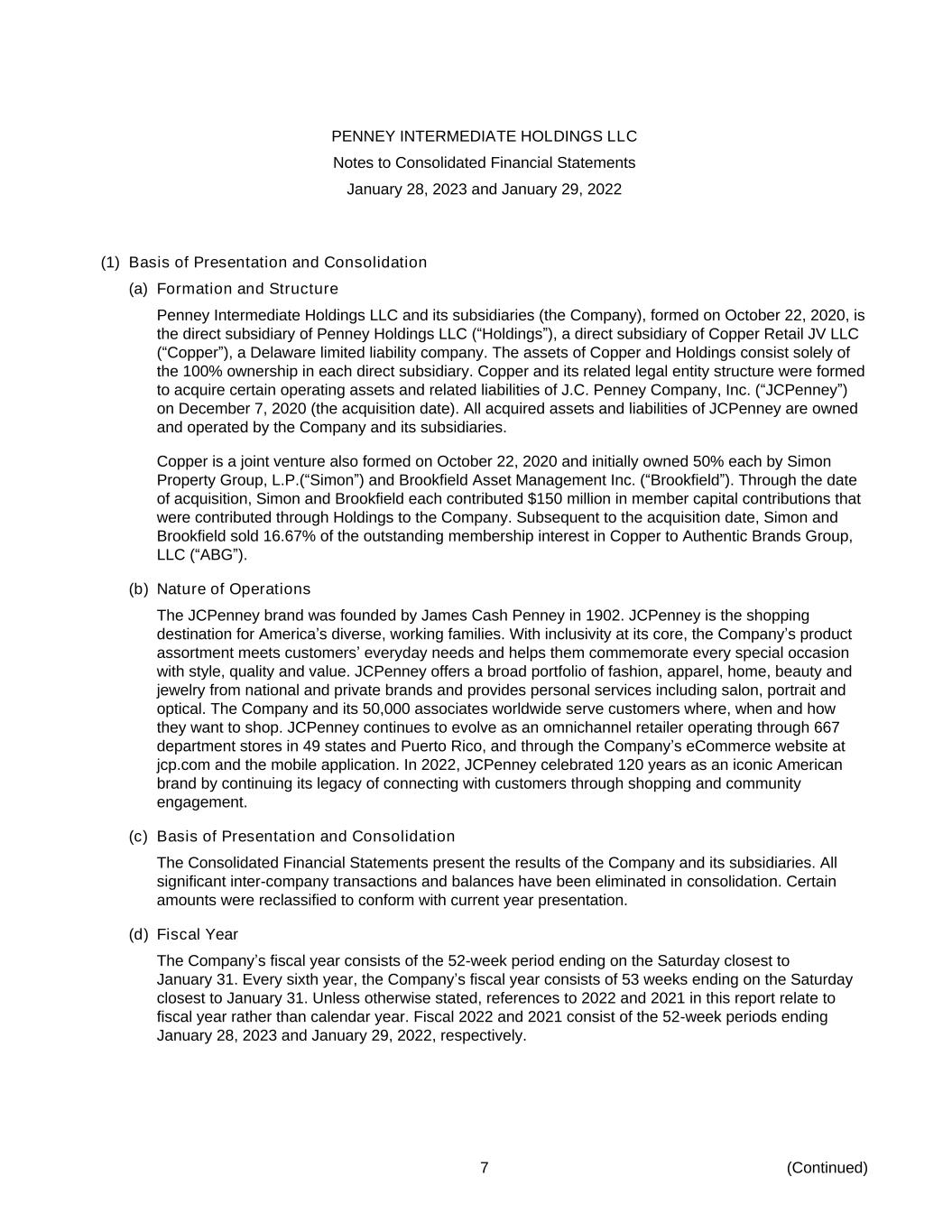
PENNEY INTERMEDIATE HOLDINGS LLC Notes to Consolidated Financial Statements January 28, 2023 and January 29, 2022 7 (Continued) (1) Basis of Presentation and Consolidation (a) Formation and Structure Penney Intermediate Holdings LLC and its subsidiaries (the Company), formed on October 22, 2020, is the direct subsidiary of Penney Holdings LLC (“Holdings”), a direct subsidiary of Copper Retail JV LLC (“Copper”), a Delaware limited liability company. The assets of Copper and Holdings consist solely of the 100% ownership in each direct subsidiary. Copper and its related legal entity structure were formed to acquire certain operating assets and related liabilities of J.C. Penney Company, Inc. (“JCPenney”) on December 7, 2020 (the acquisition date). All acquired assets and liabilities of JCPenney are owned and operated by the Company and its subsidiaries. Copper is a joint venture also formed on October 22, 2020 and initially owned 50% each by Simon Property Group, L.P.(“Simon”) and Brookfield Asset Management Inc. (“Brookfield”). Through the date of acquisition, Simon and Brookfield each contributed $150 million in member capital contributions that were contributed through Holdings to the Company. Subsequent to the acquisition date, Simon and Brookfield sold 16.67% of the outstanding membership interest in Copper to Authentic Brands Group, LLC (“ABG”). (b) Nature of Operations The JCPenney brand was founded by James Cash Penney in 1902. JCPenney is the shopping destination for America’s diverse, working families. With inclusivity at its core, the Company’s product assortment meets customers’ everyday needs and helps them commemorate every special occasion with style, quality and value. JCPenney offers a broad portfolio of fashion, apparel, home, beauty and jewelry from national and private brands and provides personal services including salon, portrait and optical. The Company and its 50,000 associates worldwide serve customers where, when and how they want to shop. JCPenney continues to evolve as an omnichannel retailer operating through 667 department stores in 49 states and Puerto Rico, and through the Company’s eCommerce website at jcp.com and the mobile application. In 2022, JCPenney celebrated 120 years as an iconic American brand by continuing its legacy of connecting with customers through shopping and community engagement. (c) Basis of Presentation and Consolidation The Consolidated Financial Statements present the results of the Company and its subsidiaries. All significant inter-company transactions and balances have been eliminated in consolidation. Certain amounts were reclassified to conform with current year presentation. (d) Fiscal Year The Company’s fiscal year consists of the 52-week period ending on the Saturday closest to January 31. Every sixth year, the Company’s fiscal year consists of 53 weeks ending on the Saturday closest to January 31. Unless otherwise stated, references to 2022 and 2021 in this report relate to fiscal year rather than calendar year. Fiscal 2022 and 2021 consist of the 52-week periods ending January 28, 2023 and January 29, 2022, respectively.
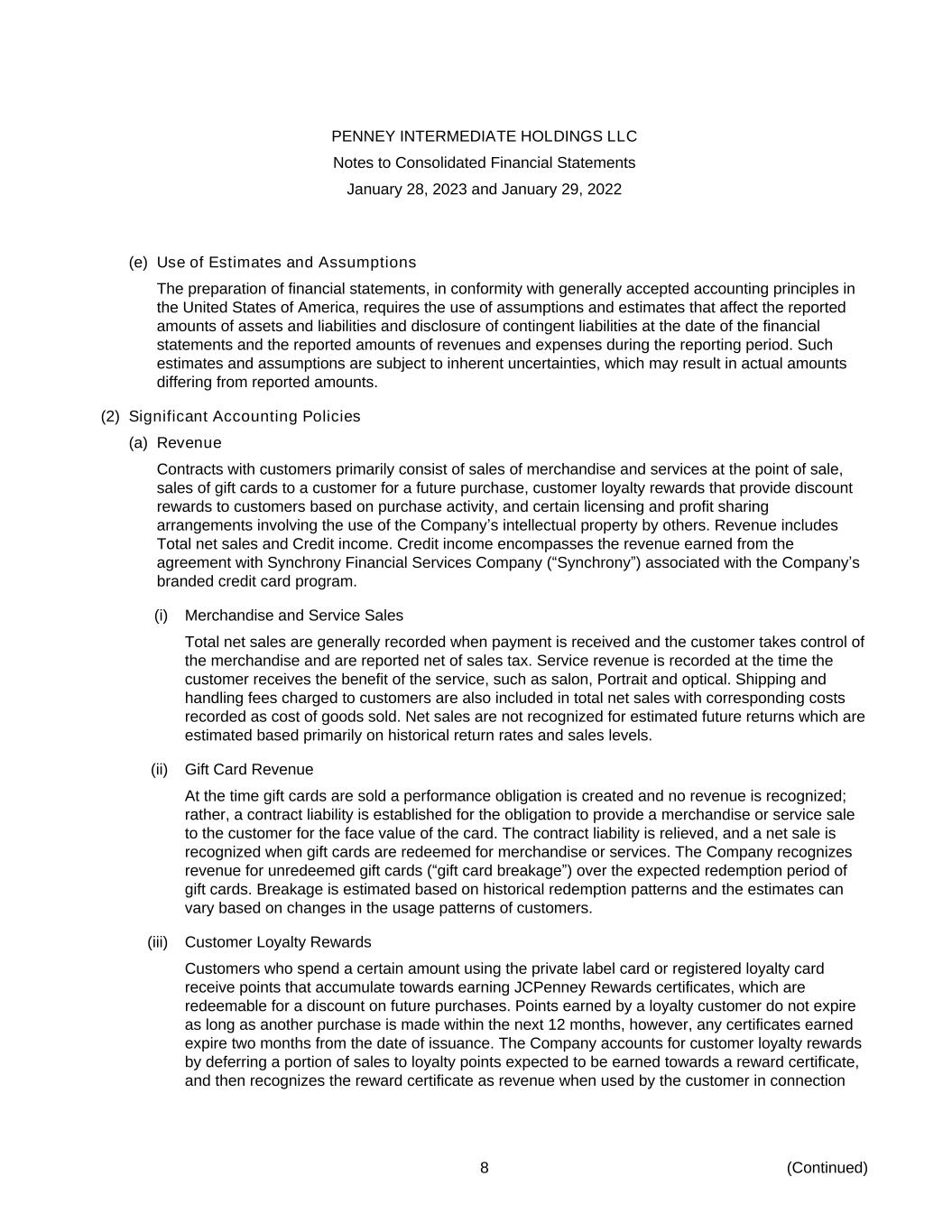
PENNEY INTERMEDIATE HOLDINGS LLC Notes to Consolidated Financial Statements January 28, 2023 and January 29, 2022 8 (Continued) (e) Use of Estimates and Assumptions The preparation of financial statements, in conformity with generally accepted accounting principles in the United States of America, requires the use of assumptions and estimates that affect the reported amounts of assets and liabilities and disclosure of contingent liabilities at the date of the financial statements and the reported amounts of revenues and expenses during the reporting period. Such estimates and assumptions are subject to inherent uncertainties, which may result in actual amounts differing from reported amounts. (2) Significant Accounting Policies (a) Revenue Contracts with customers primarily consist of sales of merchandise and services at the point of sale, sales of gift cards to a customer for a future purchase, customer loyalty rewards that provide discount rewards to customers based on purchase activity, and certain licensing and profit sharing arrangements involving the use of the Company’s intellectual property by others. Revenue includes Total net sales and Credit income. Credit income encompasses the revenue earned from the agreement with Synchrony Financial Services Company (“Synchrony”) associated with the Company’s branded credit card program. (i) Merchandise and Service Sales Total net sales are generally recorded when payment is received and the customer takes control of the merchandise and are reported net of sales tax. Service revenue is recorded at the time the customer receives the benefit of the service, such as salon, Portrait and optical. Shipping and handling fees charged to customers are also included in total net sales with corresponding costs recorded as cost of goods sold. Net sales are not recognized for estimated future returns which are estimated based primarily on historical return rates and sales levels. (ii) Gift Card Revenue At the time gift cards are sold a performance obligation is created and no revenue is recognized; rather, a contract liability is established for the obligation to provide a merchandise or service sale to the customer for the face value of the card. The contract liability is relieved, and a net sale is recognized when gift cards are redeemed for merchandise or services. The Company recognizes revenue for unredeemed gift cards (“gift card breakage”) over the expected redemption period of gift cards. Breakage is estimated based on historical redemption patterns and the estimates can vary based on changes in the usage patterns of customers. (iii) Customer Loyalty Rewards Customers who spend a certain amount using the private label card or registered loyalty card receive points that accumulate towards earning JCPenney Rewards certificates, which are redeemable for a discount on future purchases. Points earned by a loyalty customer do not expire as long as another purchase is made within the next 12 months, however, any certificates earned expire two months from the date of issuance. The Company accounts for customer loyalty rewards by deferring a portion of sales to loyalty points expected to be earned towards a reward certificate, and then recognizes the reward certificate as revenue when used by the customer in connection
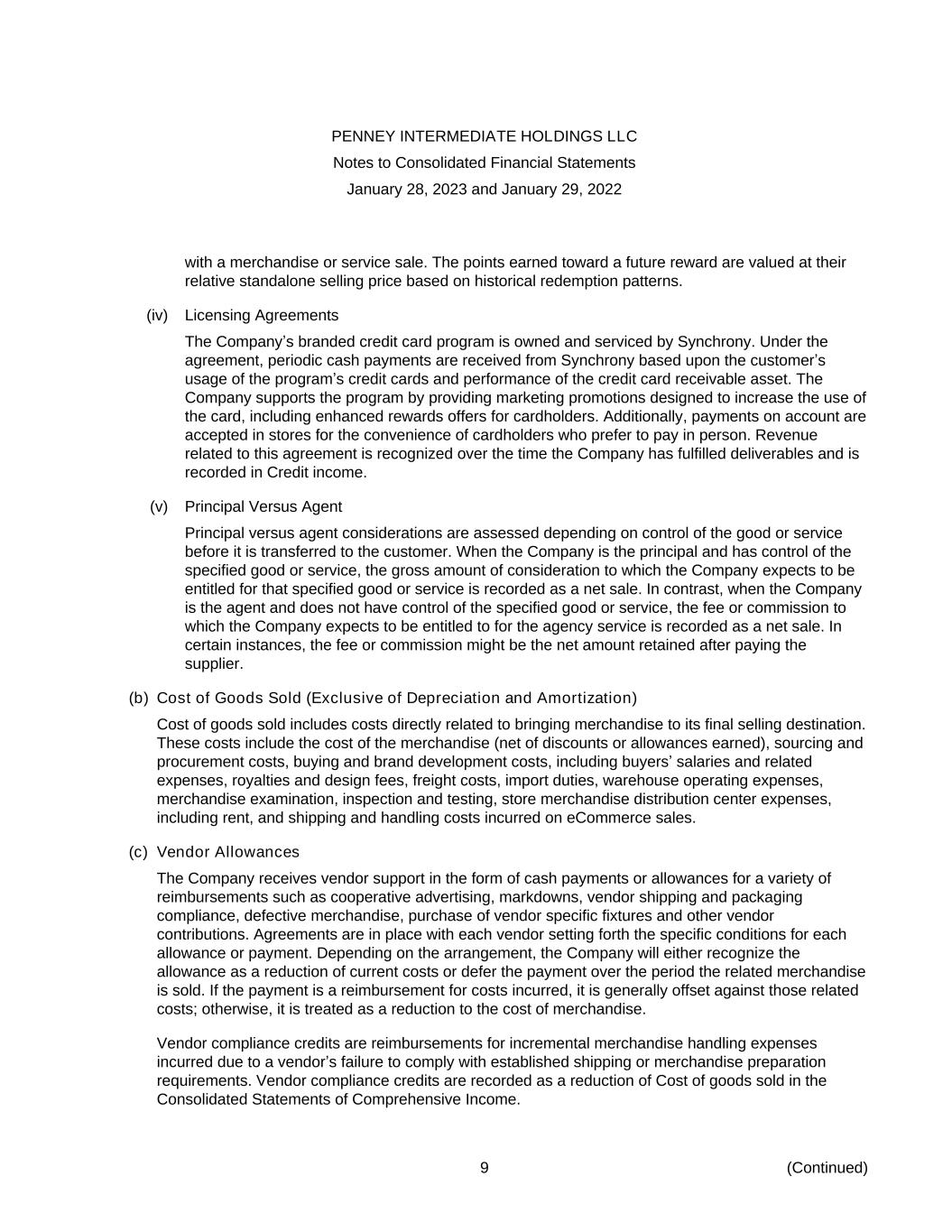
PENNEY INTERMEDIATE HOLDINGS LLC Notes to Consolidated Financial Statements January 28, 2023 and January 29, 2022 9 (Continued) with a merchandise or service sale. The points earned toward a future reward are valued at their relative standalone selling price based on historical redemption patterns. (iv) Licensing Agreements The Company’s branded credit card program is owned and serviced by Synchrony. Under the agreement, periodic cash payments are received from Synchrony based upon the customer’s usage of the program’s credit cards and performance of the credit card receivable asset. The Company supports the program by providing marketing promotions designed to increase the use of the card, including enhanced rewards offers for cardholders. Additionally, payments on account are accepted in stores for the convenience of cardholders who prefer to pay in person. Revenue related to this agreement is recognized over the time the Company has fulfilled deliverables and is recorded in Credit income. (v) Principal Versus Agent Principal versus agent considerations are assessed depending on control of the good or service before it is transferred to the customer. When the Company is the principal and has control of the specified good or service, the gross amount of consideration to which the Company expects to be entitled for that specified good or service is recorded as a net sale. In contrast, when the Company is the agent and does not have control of the specified good or service, the fee or commission to which the Company expects to be entitled to for the agency service is recorded as a net sale. In certain instances, the fee or commission might be the net amount retained after paying the supplier. (b) Cost of Goods Sold (Exclusive of Depreciation and Amortization) Cost of goods sold includes costs directly related to bringing merchandise to its final selling destination. These costs include the cost of the merchandise (net of discounts or allowances earned), sourcing and procurement costs, buying and brand development costs, including buyers’ salaries and related expenses, royalties and design fees, freight costs, import duties, warehouse operating expenses, merchandise examination, inspection and testing, store merchandise distribution center expenses, including rent, and shipping and handling costs incurred on eCommerce sales. (c) Vendor Allowances The Company receives vendor support in the form of cash payments or allowances for a variety of reimbursements such as cooperative advertising, markdowns, vendor shipping and packaging compliance, defective merchandise, purchase of vendor specific fixtures and other vendor contributions. Agreements are in place with each vendor setting forth the specific conditions for each allowance or payment. Depending on the arrangement, the Company will either recognize the allowance as a reduction of current costs or defer the payment over the period the related merchandise is sold. If the payment is a reimbursement for costs incurred, it is generally offset against those related costs; otherwise, it is treated as a reduction to the cost of merchandise. Vendor compliance credits are reimbursements for incremental merchandise handling expenses incurred due to a vendor’s failure to comply with established shipping or merchandise preparation requirements. Vendor compliance credits are recorded as a reduction of Cost of goods sold in the Consolidated Statements of Comprehensive Income.
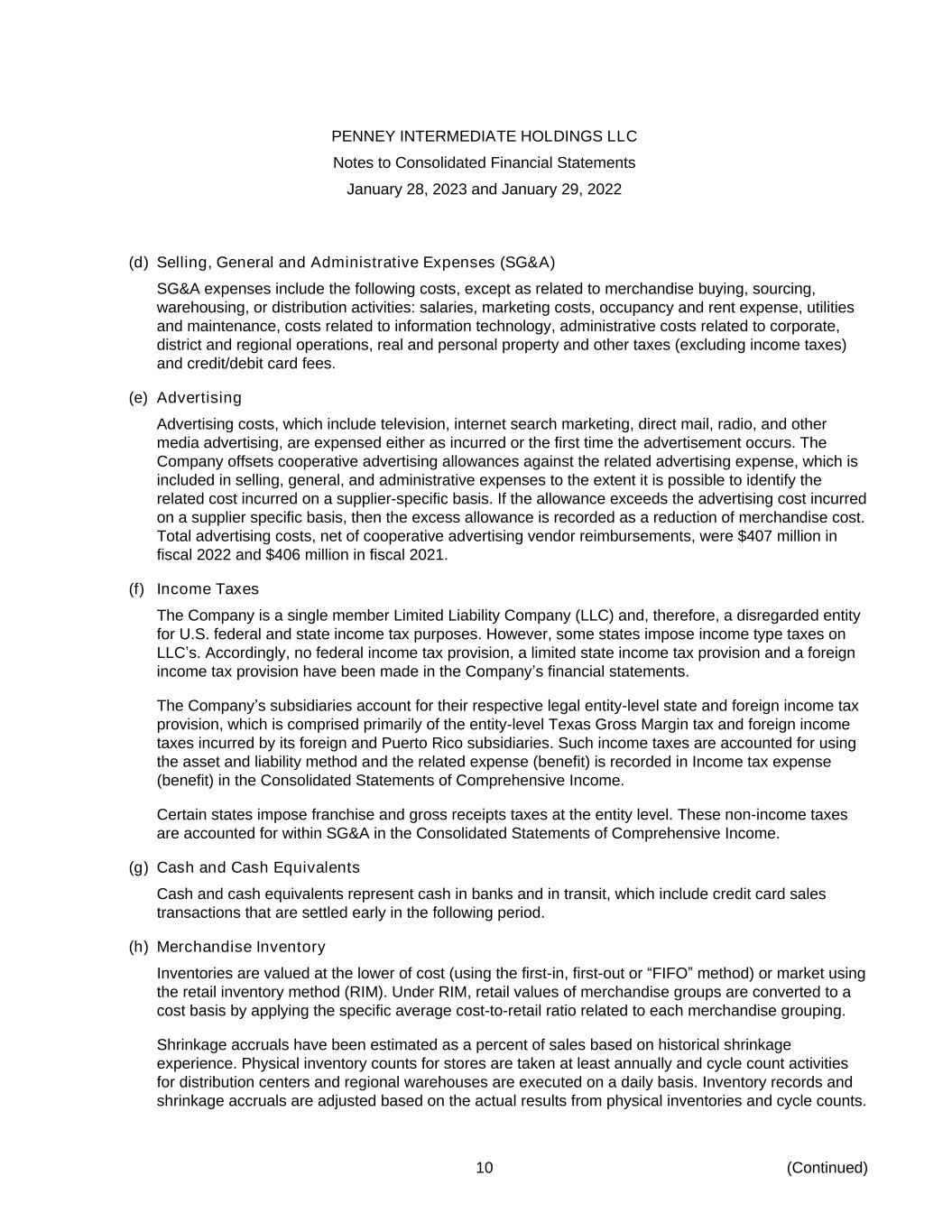
PENNEY INTERMEDIATE HOLDINGS LLC Notes to Consolidated Financial Statements January 28, 2023 and January 29, 2022 10 (Continued) (d) Selling, General and Administrative Expenses (SG&A) SG&A expenses include the following costs, except as related to merchandise buying, sourcing, warehousing, or distribution activities: salaries, marketing costs, occupancy and rent expense, utilities and maintenance, costs related to information technology, administrative costs related to corporate, district and regional operations, real and personal property and other taxes (excluding income taxes) and credit/debit card fees. (e) Advertising Advertising costs, which include television, internet search marketing, direct mail, radio, and other media advertising, are expensed either as incurred or the first time the advertisement occurs. The Company offsets cooperative advertising allowances against the related advertising expense, which is included in selling, general, and administrative expenses to the extent it is possible to identify the related cost incurred on a supplier-specific basis. If the allowance exceeds the advertising cost incurred on a supplier specific basis, then the excess allowance is recorded as a reduction of merchandise cost. Total advertising costs, net of cooperative advertising vendor reimbursements, were $407 million in fiscal 2022 and $406 million in fiscal 2021. (f) Income Taxes The Company is a single member Limited Liability Company (LLC) and, therefore, a disregarded entity for U.S. federal and state income tax purposes. However, some states impose income type taxes on LLC’s. Accordingly, no federal income tax provision, a limited state income tax provision and a foreign income tax provision have been made in the Company’s financial statements. The Company’s subsidiaries account for their respective legal entity-level state and foreign income tax provision, which is comprised primarily of the entity-level Texas Gross Margin tax and foreign income taxes incurred by its foreign and Puerto Rico subsidiaries. Such income taxes are accounted for using the asset and liability method and the related expense (benefit) is recorded in Income tax expense (benefit) in the Consolidated Statements of Comprehensive Income. Certain states impose franchise and gross receipts taxes at the entity level. These non-income taxes are accounted for within SG&A in the Consolidated Statements of Comprehensive Income. (g) Cash and Cash Equivalents Cash and cash equivalents represent cash in banks and in transit, which include credit card sales transactions that are settled early in the following period. (h) Merchandise Inventory Inventories are valued at the lower of cost (using the first-in, first-out or “FIFO” method) or market using the retail inventory method (RIM). Under RIM, retail values of merchandise groups are converted to a cost basis by applying the specific average cost-to-retail ratio related to each merchandise grouping. Shrinkage accruals have been estimated as a percent of sales based on historical shrinkage experience. Physical inventory counts for stores are taken at least annually and cycle count activities for distribution centers and regional warehouses are executed on a daily basis. Inventory records and shrinkage accruals are adjusted based on the actual results from physical inventories and cycle counts.
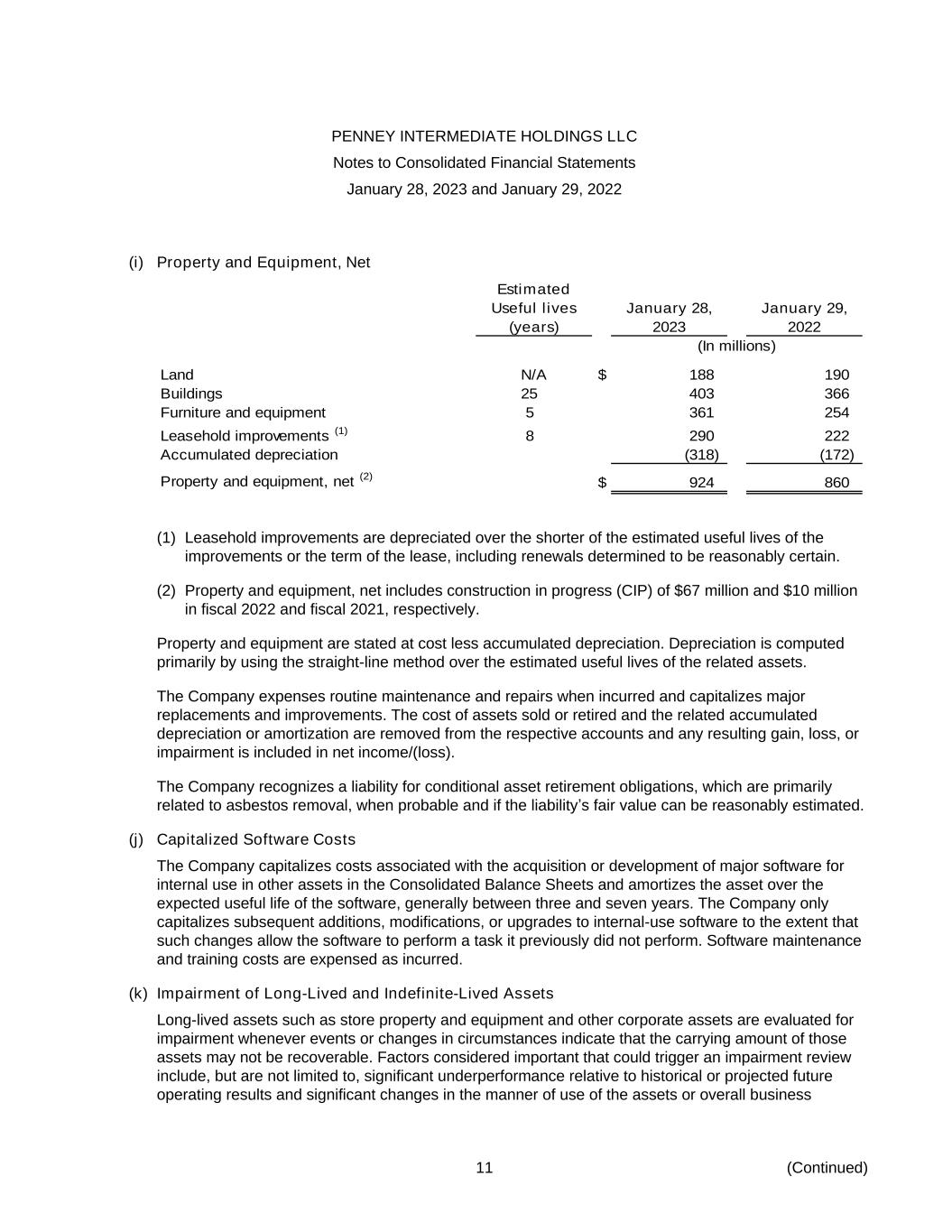
PENNEY INTERMEDIATE HOLDINGS LLC Notes to Consolidated Financial Statements January 28, 2023 and January 29, 2022 11 (Continued) (i) Property and Equipment, Net Estimated Useful lives January 28, January 29, (years) 2023 2022 (In millions) Land N/A $ 188 190 Buildings 25 403 366 Furniture and equipment 5 361 254 Leasehold improvements (1) 8 290 222 Accumulated depreciation (318) (172) Property and equipment, net (2) $ 924 860 (1) Leasehold improvements are depreciated over the shorter of the estimated useful lives of the improvements or the term of the lease, including renewals determined to be reasonably certain. (2) Property and equipment, net includes construction in progress (CIP) of $67 million and $10 million in fiscal 2022 and fiscal 2021, respectively. Property and equipment are stated at cost less accumulated depreciation. Depreciation is computed primarily by using the straight-line method over the estimated useful lives of the related assets. The Company expenses routine maintenance and repairs when incurred and capitalizes major replacements and improvements. The cost of assets sold or retired and the related accumulated depreciation or amortization are removed from the respective accounts and any resulting gain, loss, or impairment is included in net income/(loss). The Company recognizes a liability for conditional asset retirement obligations, which are primarily related to asbestos removal, when probable and if the liability’s fair value can be reasonably estimated. (j) Capitalized Software Costs The Company capitalizes costs associated with the acquisition or development of major software for internal use in other assets in the Consolidated Balance Sheets and amortizes the asset over the expected useful life of the software, generally between three and seven years. The Company only capitalizes subsequent additions, modifications, or upgrades to internal-use software to the extent that such changes allow the software to perform a task it previously did not perform. Software maintenance and training costs are expensed as incurred. (k) Impairment of Long-Lived and Indefinite-Lived Assets Long-lived assets such as store property and equipment and other corporate assets are evaluated for impairment whenever events or changes in circumstances indicate that the carrying amount of those assets may not be recoverable. Factors considered important that could trigger an impairment review include, but are not limited to, significant underperformance relative to historical or projected future operating results and significant changes in the manner of use of the assets or overall business
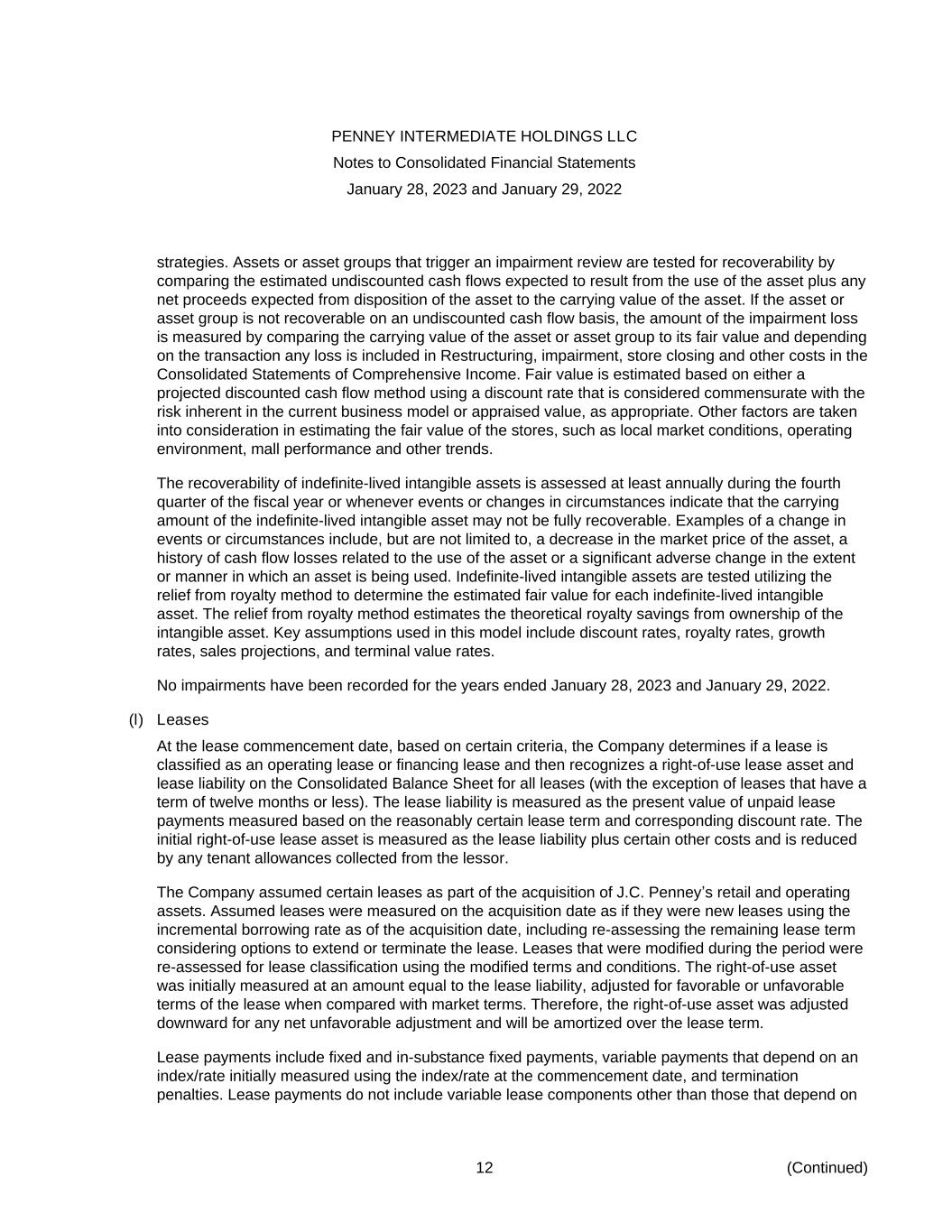
PENNEY INTERMEDIATE HOLDINGS LLC Notes to Consolidated Financial Statements January 28, 2023 and January 29, 2022 12 (Continued) strategies. Assets or asset groups that trigger an impairment review are tested for recoverability by comparing the estimated undiscounted cash flows expected to result from the use of the asset plus any net proceeds expected from disposition of the asset to the carrying value of the asset. If the asset or asset group is not recoverable on an undiscounted cash flow basis, the amount of the impairment loss is measured by comparing the carrying value of the asset or asset group to its fair value and depending on the transaction any loss is included in Restructuring, impairment, store closing and other costs in the Consolidated Statements of Comprehensive Income. Fair value is estimated based on either a projected discounted cash flow method using a discount rate that is considered commensurate with the risk inherent in the current business model or appraised value, as appropriate. Other factors are taken into consideration in estimating the fair value of the stores, such as local market conditions, operating environment, mall performance and other trends. The recoverability of indefinite-lived intangible assets is assessed at least annually during the fourth quarter of the fiscal year or whenever events or changes in circumstances indicate that the carrying amount of the indefinite-lived intangible asset may not be fully recoverable. Examples of a change in events or circumstances include, but are not limited to, a decrease in the market price of the asset, a history of cash flow losses related to the use of the asset or a significant adverse change in the extent or manner in which an asset is being used. Indefinite-lived intangible assets are tested utilizing the relief from royalty method to determine the estimated fair value for each indefinite-lived intangible asset. The relief from royalty method estimates the theoretical royalty savings from ownership of the intangible asset. Key assumptions used in this model include discount rates, royalty rates, growth rates, sales projections, and terminal value rates. No impairments have been recorded for the years ended January 28, 2023 and January 29, 2022. (l) Leases At the lease commencement date, based on certain criteria, the Company determines if a lease is classified as an operating lease or financing lease and then recognizes a right-of-use lease asset and lease liability on the Consolidated Balance Sheet for all leases (with the exception of leases that have a term of twelve months or less). The lease liability is measured as the present value of unpaid lease payments measured based on the reasonably certain lease term and corresponding discount rate. The initial right-of-use lease asset is measured as the lease liability plus certain other costs and is reduced by any tenant allowances collected from the lessor. The Company assumed certain leases as part of the acquisition of J.C. Penney’s retail and operating assets. Assumed leases were measured on the acquisition date as if they were new leases using the incremental borrowing rate as of the acquisition date, including re-assessing the remaining lease term considering options to extend or terminate the lease. Leases that were modified during the period were re-assessed for lease classification using the modified terms and conditions. The right-of-use asset was initially measured at an amount equal to the lease liability, adjusted for favorable or unfavorable terms of the lease when compared with market terms. Therefore, the right-of-use asset was adjusted downward for any net unfavorable adjustment and will be amortized over the lease term. Lease payments include fixed and in-substance fixed payments, variable payments that depend on an index/rate initially measured using the index/rate at the commencement date, and termination penalties. Lease payments do not include variable lease components other than those that depend on
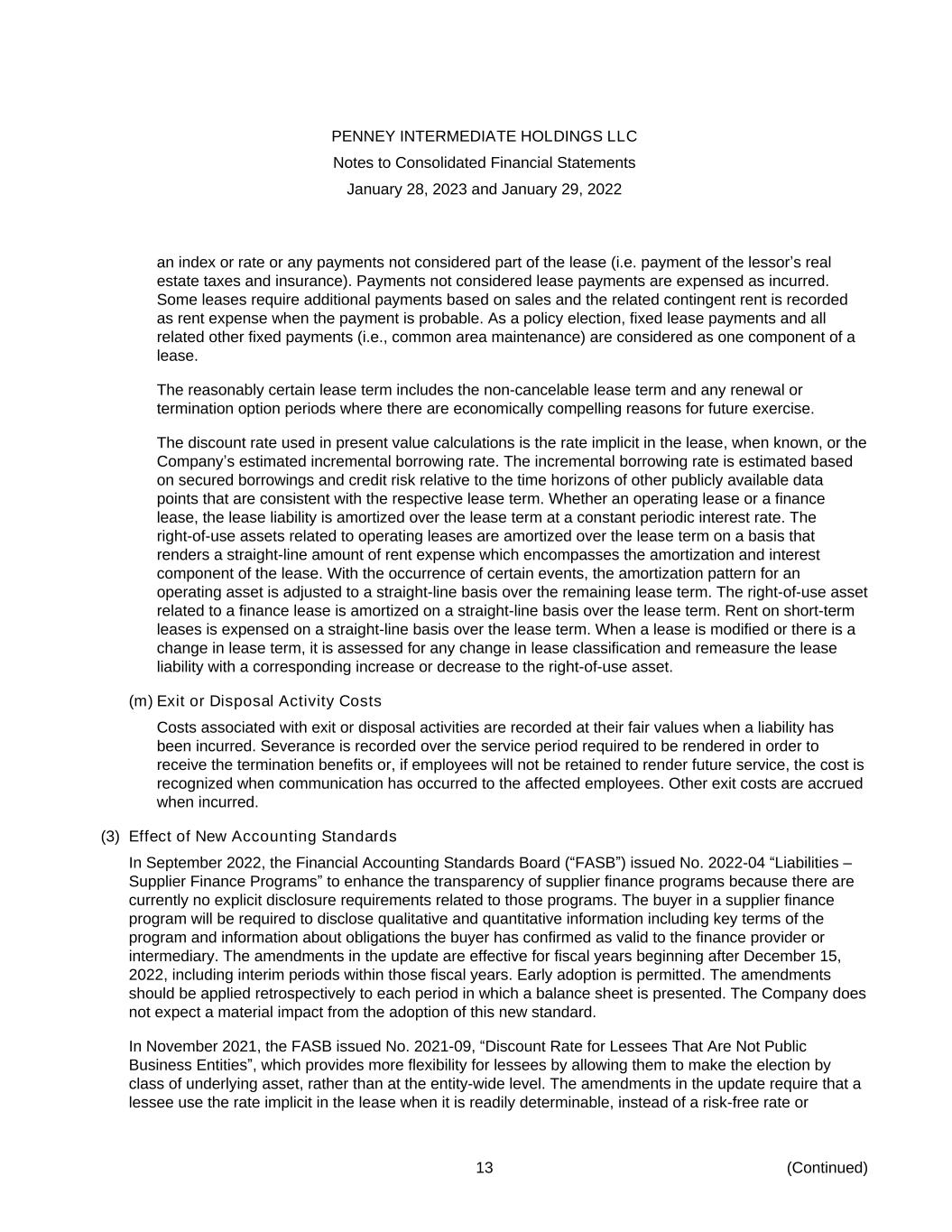
PENNEY INTERMEDIATE HOLDINGS LLC Notes to Consolidated Financial Statements January 28, 2023 and January 29, 2022 13 (Continued) an index or rate or any payments not considered part of the lease (i.e. payment of the lessor’s real estate taxes and insurance). Payments not considered lease payments are expensed as incurred. Some leases require additional payments based on sales and the related contingent rent is recorded as rent expense when the payment is probable. As a policy election, fixed lease payments and all related other fixed payments (i.e., common area maintenance) are considered as one component of a lease. The reasonably certain lease term includes the non-cancelable lease term and any renewal or termination option periods where there are economically compelling reasons for future exercise. The discount rate used in present value calculations is the rate implicit in the lease, when known, or the Company’s estimated incremental borrowing rate. The incremental borrowing rate is estimated based on secured borrowings and credit risk relative to the time horizons of other publicly available data points that are consistent with the respective lease term. Whether an operating lease or a finance lease, the lease liability is amortized over the lease term at a constant periodic interest rate. The right-of-use assets related to operating leases are amortized over the lease term on a basis that renders a straight-line amount of rent expense which encompasses the amortization and interest component of the lease. With the occurrence of certain events, the amortization pattern for an operating asset is adjusted to a straight-line basis over the remaining lease term. The right-of-use asset related to a finance lease is amortized on a straight-line basis over the lease term. Rent on short-term leases is expensed on a straight-line basis over the lease term. When a lease is modified or there is a change in lease term, it is assessed for any change in lease classification and remeasure the lease liability with a corresponding increase or decrease to the right-of-use asset. (m) Exit or Disposal Activity Costs Costs associated with exit or disposal activities are recorded at their fair values when a liability has been incurred. Severance is recorded over the service period required to be rendered in order to receive the termination benefits or, if employees will not be retained to render future service, the cost is recognized when communication has occurred to the affected employees. Other exit costs are accrued when incurred. (3) Effect of New Accounting Standards In September 2022, the Financial Accounting Standards Board (“FASB”) issued No. 2022-04 “Liabilities – Supplier Finance Programs” to enhance the transparency of supplier finance programs because there are currently no explicit disclosure requirements related to those programs. The buyer in a supplier finance program will be required to disclose qualitative and quantitative information including key terms of the program and information about obligations the buyer has confirmed as valid to the finance provider or intermediary. The amendments in the update are effective for fiscal years beginning after December 15, 2022, including interim periods within those fiscal years. Early adoption is permitted. The amendments should be applied retrospectively to each period in which a balance sheet is presented. The Company does not expect a material impact from the adoption of this new standard. In November 2021, the FASB issued No. 2021-09, “Discount Rate for Lessees That Are Not Public Business Entities”, which provides more flexibility for lessees by allowing them to make the election by class of underlying asset, rather than at the entity-wide level. The amendments in the update require that a lessee use the rate implicit in the lease when it is readily determinable, instead of a risk-free rate or
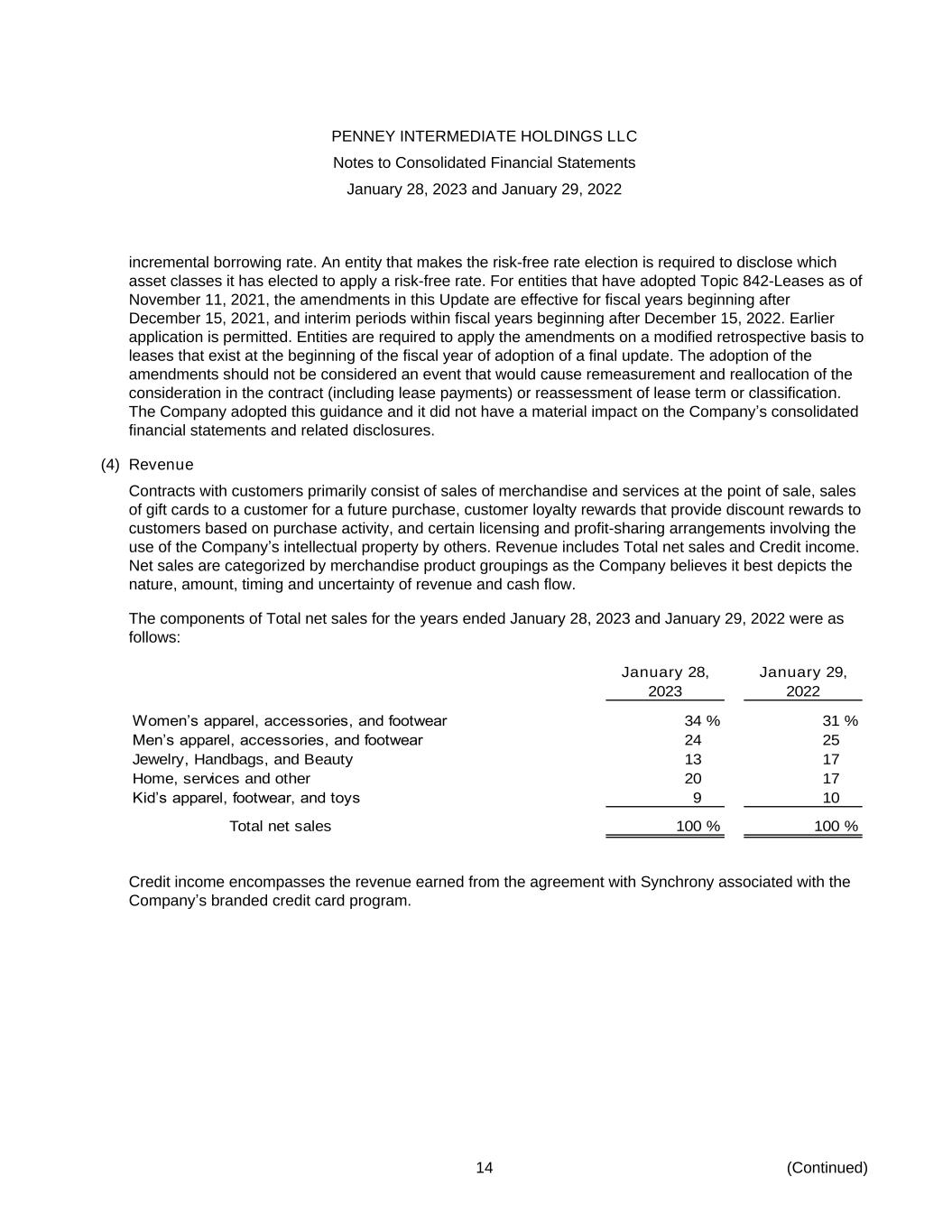
PENNEY INTERMEDIATE HOLDINGS LLC Notes to Consolidated Financial Statements January 28, 2023 and January 29, 2022 14 (Continued) incremental borrowing rate. An entity that makes the risk-free rate election is required to disclose which asset classes it has elected to apply a risk-free rate. For entities that have adopted Topic 842-Leases as of November 11, 2021, the amendments in this Update are effective for fiscal years beginning after December 15, 2021, and interim periods within fiscal years beginning after December 15, 2022. Earlier application is permitted. Entities are required to apply the amendments on a modified retrospective basis to leases that exist at the beginning of the fiscal year of adoption of a final update. The adoption of the amendments should not be considered an event that would cause remeasurement and reallocation of the consideration in the contract (including lease payments) or reassessment of lease term or classification. The Company adopted this guidance and it did not have a material impact on the Company’s consolidated financial statements and related disclosures. (4) Revenue Contracts with customers primarily consist of sales of merchandise and services at the point of sale, sales of gift cards to a customer for a future purchase, customer loyalty rewards that provide discount rewards to customers based on purchase activity, and certain licensing and profit-sharing arrangements involving the use of the Company’s intellectual property by others. Revenue includes Total net sales and Credit income. Net sales are categorized by merchandise product groupings as the Company believes it best depicts the nature, amount, timing and uncertainty of revenue and cash flow. The components of Total net sales for the years ended January 28, 2023 and January 29, 2022 were as follows: January 28, January 29, 2023 2022 Women’s apparel, accessories, and footwear 34 % 31 % Men’s apparel, accessories, and footwear 24 25 Jewelry, Handbags, and Beauty 13 17 Home, services and other 20 17 Kid’s apparel, footwear, and toys 9 10 Total net sales 100 % 100 % Credit income encompasses the revenue earned from the agreement with Synchrony associated with the Company’s branded credit card program.
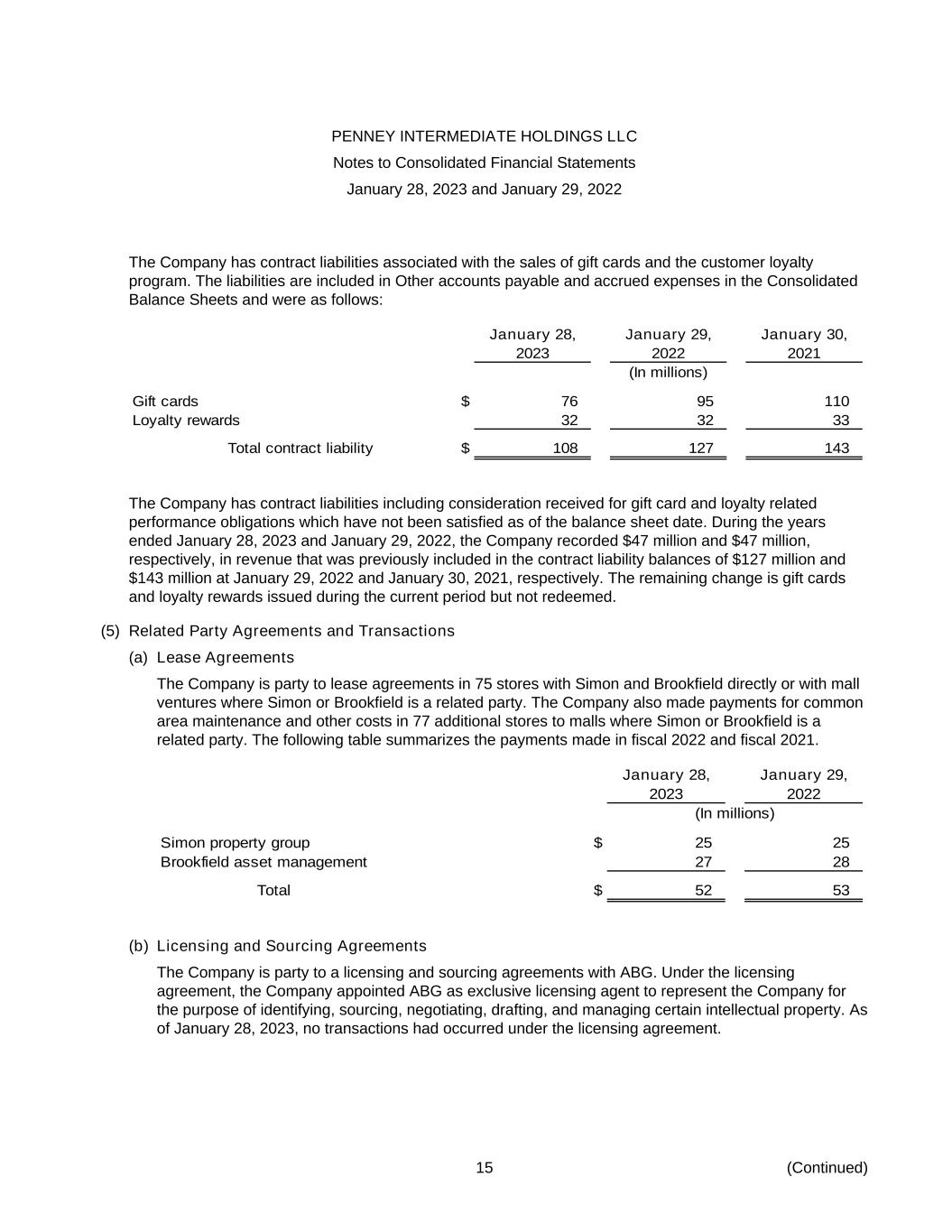
PENNEY INTERMEDIATE HOLDINGS LLC Notes to Consolidated Financial Statements January 28, 2023 and January 29, 2022 15 (Continued) The Company has contract liabilities associated with the sales of gift cards and the customer loyalty program. The liabilities are included in Other accounts payable and accrued expenses in the Consolidated Balance Sheets and were as follows: January 28, January 29, January 30, 2023 2022 2021 (In millions) Gift cards $ 76 95 110 Loyalty rewards 32 32 33 Total contract liability $ 108 127 143 The Company has contract liabilities including consideration received for gift card and loyalty related performance obligations which have not been satisfied as of the balance sheet date. During the years ended January 28, 2023 and January 29, 2022, the Company recorded $47 million and $47 million, respectively, in revenue that was previously included in the contract liability balances of $127 million and $143 million at January 29, 2022 and January 30, 2021, respectively. The remaining change is gift cards and loyalty rewards issued during the current period but not redeemed. (5) Related Party Agreements and Transactions (a) Lease Agreements The Company is party to lease agreements in 75 stores with Simon and Brookfield directly or with mall ventures where Simon or Brookfield is a related party. The Company also made payments for common area maintenance and other costs in 77 additional stores to malls where Simon or Brookfield is a related party. The following table summarizes the payments made in fiscal 2022 and fiscal 2021. January 28, January 29, 2023 2022 (In millions) Simon property group $ 25 25 Brookfield asset management 27 28 Total $ 52 53 (b) Licensing and Sourcing Agreements The Company is party to a licensing and sourcing agreements with ABG. Under the licensing agreement, the Company appointed ABG as exclusive licensing agent to represent the Company for the purpose of identifying, sourcing, negotiating, drafting, and managing certain intellectual property. As of January 28, 2023, no transactions had occurred under the licensing agreement.
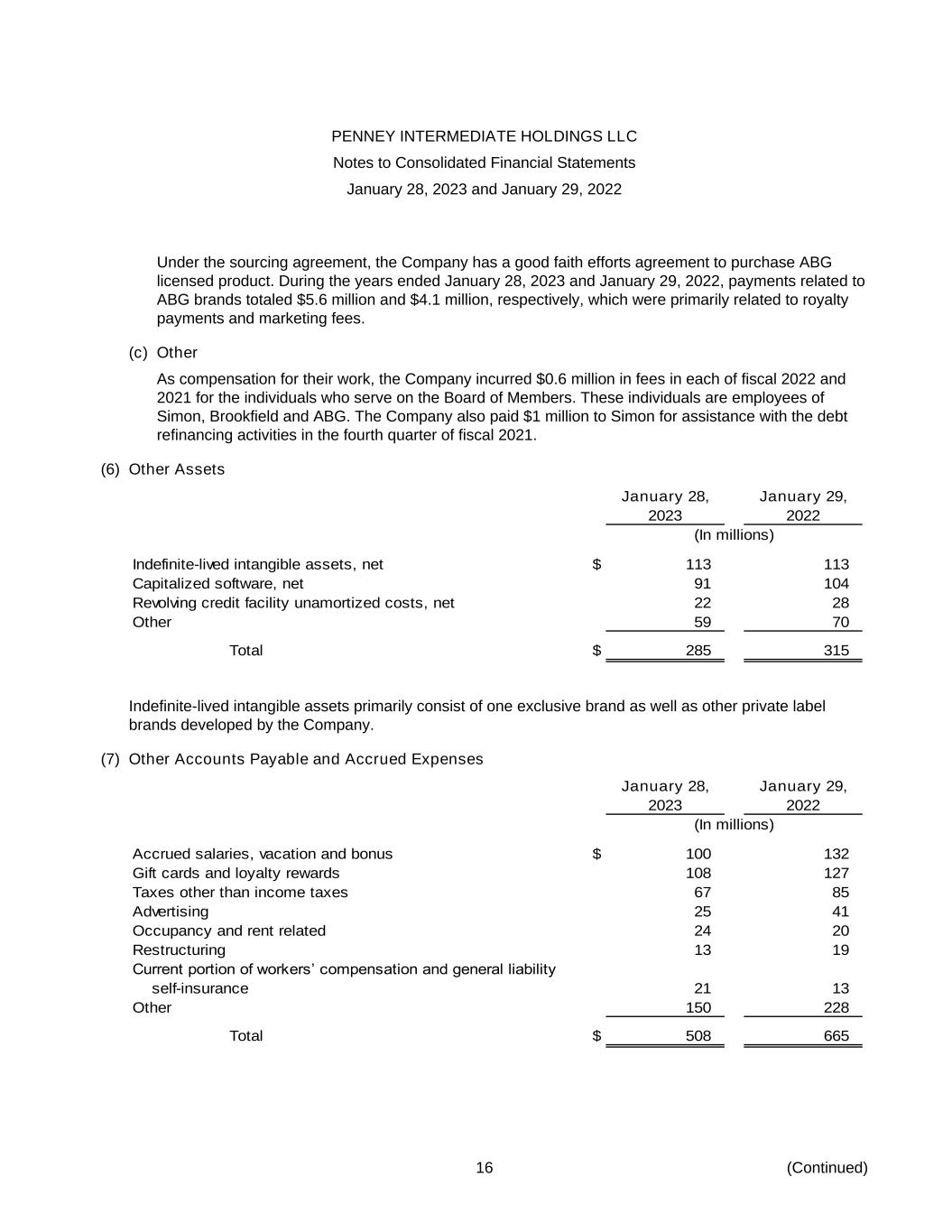
PENNEY INTERMEDIATE HOLDINGS LLC Notes to Consolidated Financial Statements January 28, 2023 and January 29, 2022 16 (Continued) Under the sourcing agreement, the Company has a good faith efforts agreement to purchase ABG licensed product. During the years ended January 28, 2023 and January 29, 2022, payments related to ABG brands totaled $5.6 million and $4.1 million, respectively, which were primarily related to royalty payments and marketing fees. (c) Other As compensation for their work, the Company incurred $0.6 million in fees in each of fiscal 2022 and 2021 for the individuals who serve on the Board of Members. These individuals are employees of Simon, Brookfield and ABG. The Company also paid $1 million to Simon for assistance with the debt refinancing activities in the fourth quarter of fiscal 2021. (6) Other Assets January 28, January 29, 2023 2022 (In millions) Indefinite-lived intangible assets, net $ 113 113 Capitalized software, net 91 104 Revolving credit facility unamortized costs, net 22 28 Other 59 70 Total $ 285 315 Indefinite-lived intangible assets primarily consist of one exclusive brand as well as other private label brands developed by the Company. (7) Other Accounts Payable and Accrued Expenses January 28, January 29, 2023 2022 (In millions) Accrued salaries, vacation and bonus $ 100 132 Gift cards and loyalty rewards 108 127 Taxes other than income taxes 67 85 Advertising 25 41 Occupancy and rent related 24 20 Restructuring 13 19 Current portion of workers’ compensation and general liability self-insurance 21 13 Other 150 228 Total $ 508 665
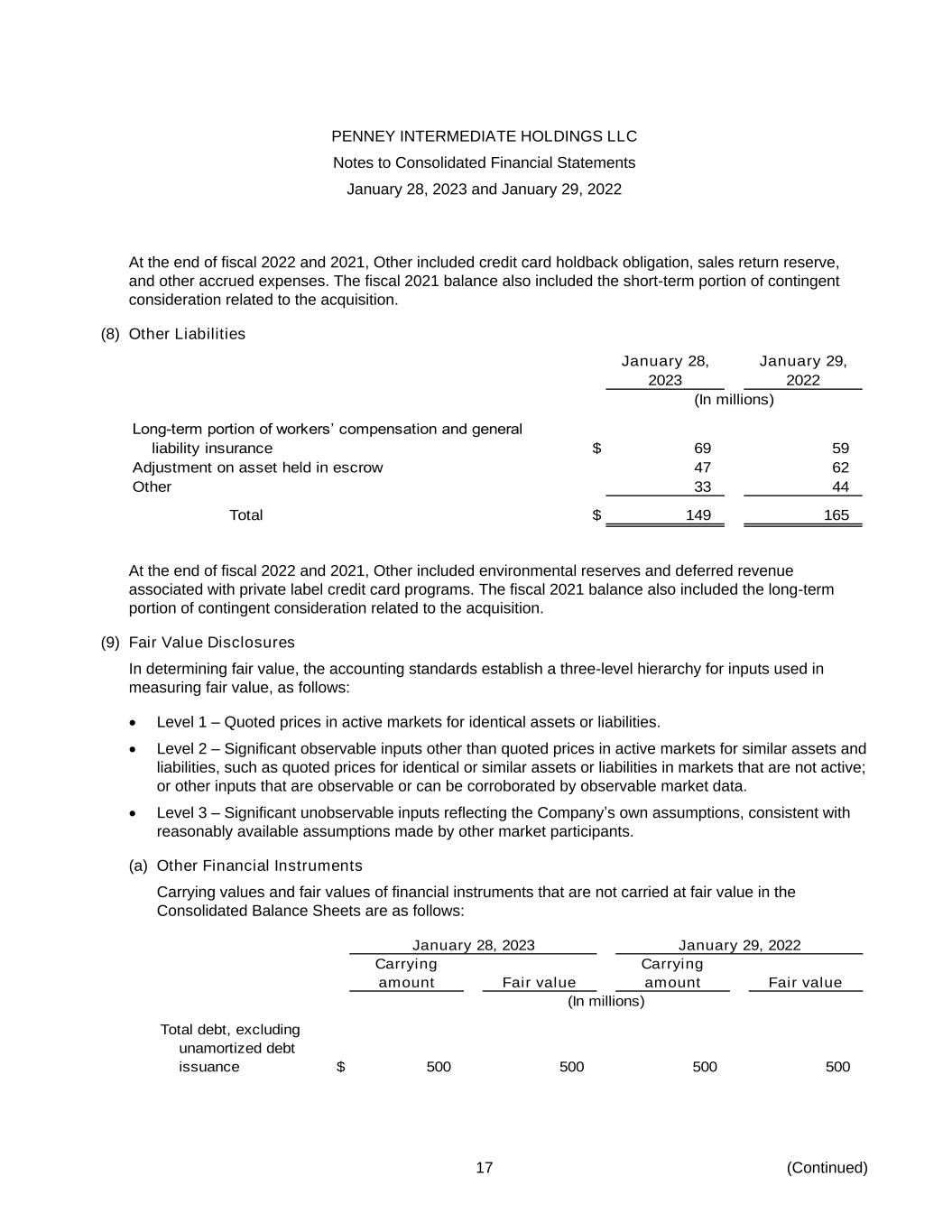
PENNEY INTERMEDIATE HOLDINGS LLC Notes to Consolidated Financial Statements January 28, 2023 and January 29, 2022 17 (Continued) At the end of fiscal 2022 and 2021, Other included credit card holdback obligation, sales return reserve, and other accrued expenses. The fiscal 2021 balance also included the short-term portion of contingent consideration related to the acquisition. (8) Other Liabilities January 28, January 29, 2023 2022 (In millions) Long-term portion of workers’ compensation and general liability insurance $ 69 59 Adjustment on asset held in escrow 47 62 Other 33 44 Total $ 149 165 At the end of fiscal 2022 and 2021, Other included environmental reserves and deferred revenue associated with private label credit card programs. The fiscal 2021 balance also included the long-term portion of contingent consideration related to the acquisition. (9) Fair Value Disclosures In determining fair value, the accounting standards establish a three-level hierarchy for inputs used in measuring fair value, as follows: • Level 1 – Quoted prices in active markets for identical assets or liabilities. • Level 2 – Significant observable inputs other than quoted prices in active markets for similar assets and liabilities, such as quoted prices for identical or similar assets or liabilities in markets that are not active; or other inputs that are observable or can be corroborated by observable market data. • Level 3 – Significant unobservable inputs reflecting the Company’s own assumptions, consistent with reasonably available assumptions made by other market participants. (a) Other Financial Instruments Carrying values and fair values of financial instruments that are not carried at fair value in the Consolidated Balance Sheets are as follows: January 28, 2023 January 29, 2022 Carrying Carrying amount Fair value amount Fair value (In millions) Total debt, excluding unamortized debt issuance $ 500 500 500 500
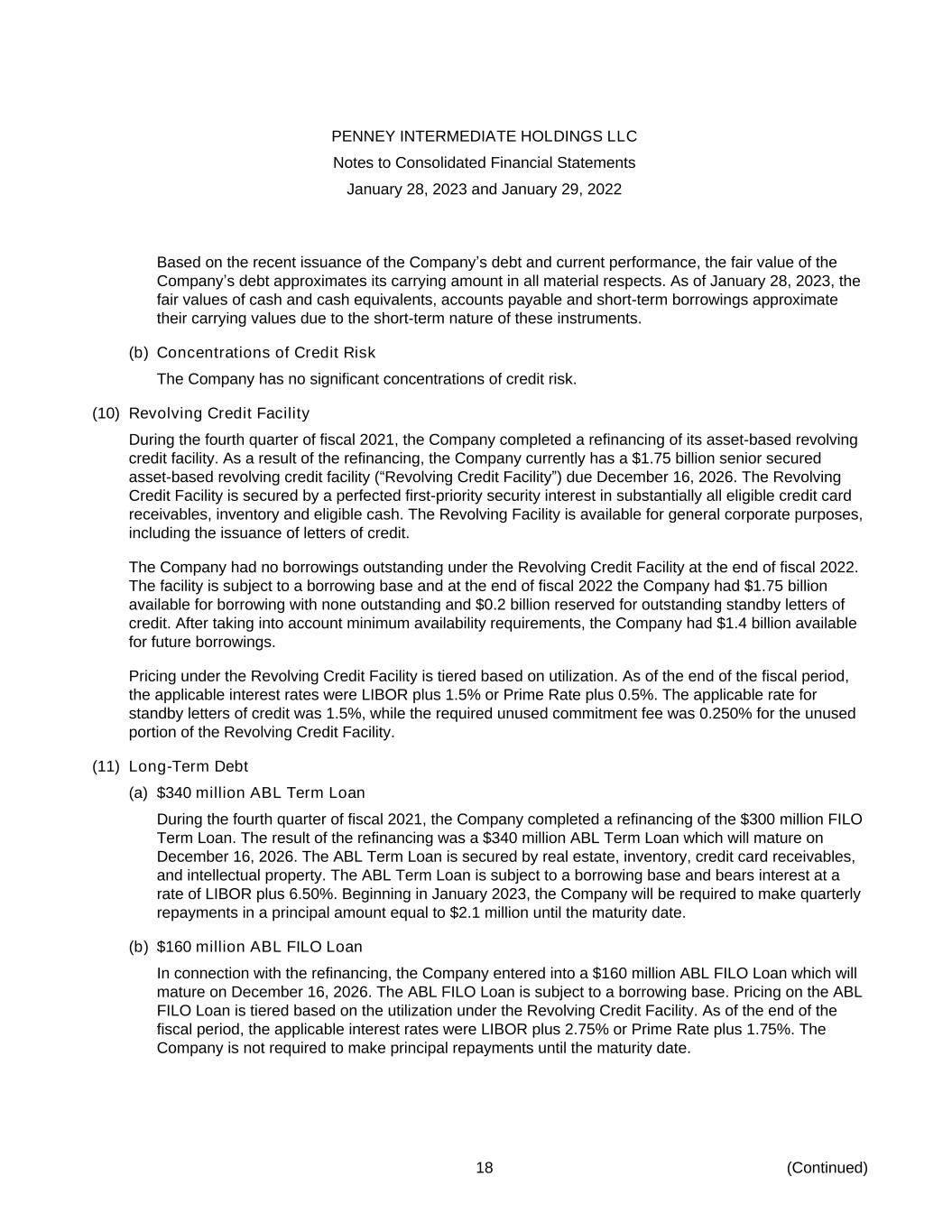
PENNEY INTERMEDIATE HOLDINGS LLC Notes to Consolidated Financial Statements January 28, 2023 and January 29, 2022 18 (Continued) Based on the recent issuance of the Company’s debt and current performance, the fair value of the Company’s debt approximates its carrying amount in all material respects. As of January 28, 2023, the fair values of cash and cash equivalents, accounts payable and short-term borrowings approximate their carrying values due to the short-term nature of these instruments. (b) Concentrations of Credit Risk The Company has no significant concentrations of credit risk. (10) Revolving Credit Facility During the fourth quarter of fiscal 2021, the Company completed a refinancing of its asset-based revolving credit facility. As a result of the refinancing, the Company currently has a $1.75 billion senior secured asset-based revolving credit facility (“Revolving Credit Facility”) due December 16, 2026. The Revolving Credit Facility is secured by a perfected first-priority security interest in substantially all eligible credit card receivables, inventory and eligible cash. The Revolving Facility is available for general corporate purposes, including the issuance of letters of credit. The Company had no borrowings outstanding under the Revolving Credit Facility at the end of fiscal 2022. The facility is subject to a borrowing base and at the end of fiscal 2022 the Company had $1.75 billion available for borrowing with none outstanding and $0.2 billion reserved for outstanding standby letters of credit. After taking into account minimum availability requirements, the Company had $1.4 billion available for future borrowings. Pricing under the Revolving Credit Facility is tiered based on utilization. As of the end of the fiscal period, the applicable interest rates were LIBOR plus 1.5% or Prime Rate plus 0.5%. The applicable rate for standby letters of credit was 1.5%, while the required unused commitment fee was 0.250% for the unused portion of the Revolving Credit Facility. (11) Long-Term Debt (a) $340 million ABL Term Loan During the fourth quarter of fiscal 2021, the Company completed a refinancing of the $300 million FILO Term Loan. The result of the refinancing was a $340 million ABL Term Loan which will mature on December 16, 2026. The ABL Term Loan is secured by real estate, inventory, credit card receivables, and intellectual property. The ABL Term Loan is subject to a borrowing base and bears interest at a rate of LIBOR plus 6.50%. Beginning in January 2023, the Company will be required to make quarterly repayments in a principal amount equal to $2.1 million until the maturity date. (b) $160 million ABL FILO Loan In connection with the refinancing, the Company entered into a $160 million ABL FILO Loan which will mature on December 16, 2026. The ABL FILO Loan is subject to a borrowing base. Pricing on the ABL FILO Loan is tiered based on the utilization under the Revolving Credit Facility. As of the end of the fiscal period, the applicable interest rates were LIBOR plus 2.75% or Prime Rate plus 1.75%. The Company is not required to make principal repayments until the maturity date.
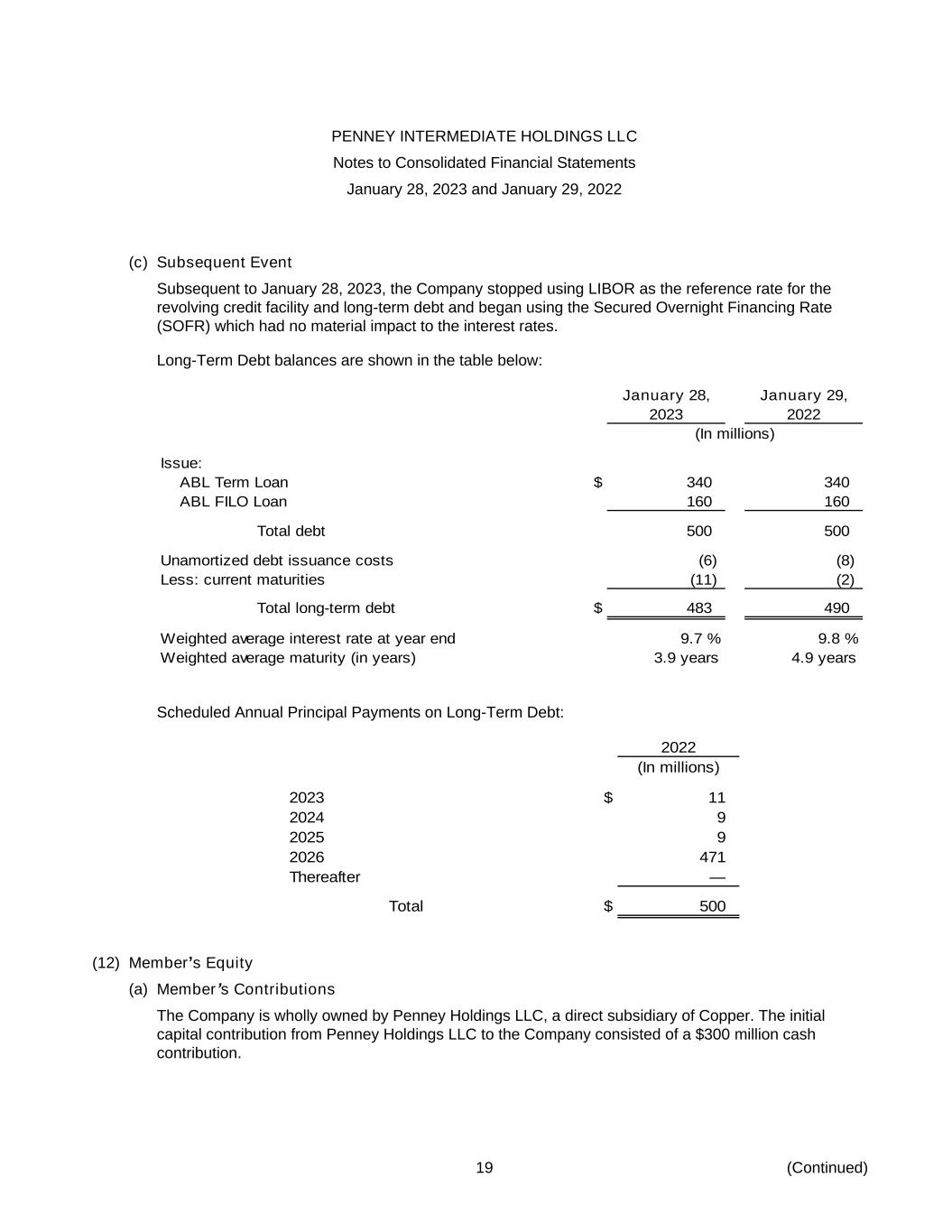
PENNEY INTERMEDIATE HOLDINGS LLC Notes to Consolidated Financial Statements January 28, 2023 and January 29, 2022 19 (Continued) (c) Subsequent Event Subsequent to January 28, 2023, the Company stopped using LIBOR as the reference rate for the revolving credit facility and long-term debt and began using the Secured Overnight Financing Rate (SOFR) which had no material impact to the interest rates. Long-Term Debt balances are shown in the table below: January 28, January 29, 2023 2022 (In millions) Issue: ABL Term Loan $ 340 340 ABL FILO Loan 160 160 Total debt 500 500 Unamortized debt issuance costs (6) (8) Less: current maturities (11) (2) Total long-term debt $ 483 490 Weighted average interest rate at year end 9.7 % 9.8 % Weighted average maturity (in years) 3.9 years 4.9 years Scheduled Annual Principal Payments on Long-Term Debt: 2022 (In millions) 2023 $ 11 2024 9 2025 9 2026 471 Thereafter — Total $ 500 (12) Member’s Equity (a) Member’s Contributions The Company is wholly owned by Penney Holdings LLC, a direct subsidiary of Copper. The initial capital contribution from Penney Holdings LLC to the Company consisted of a $300 million cash contribution.
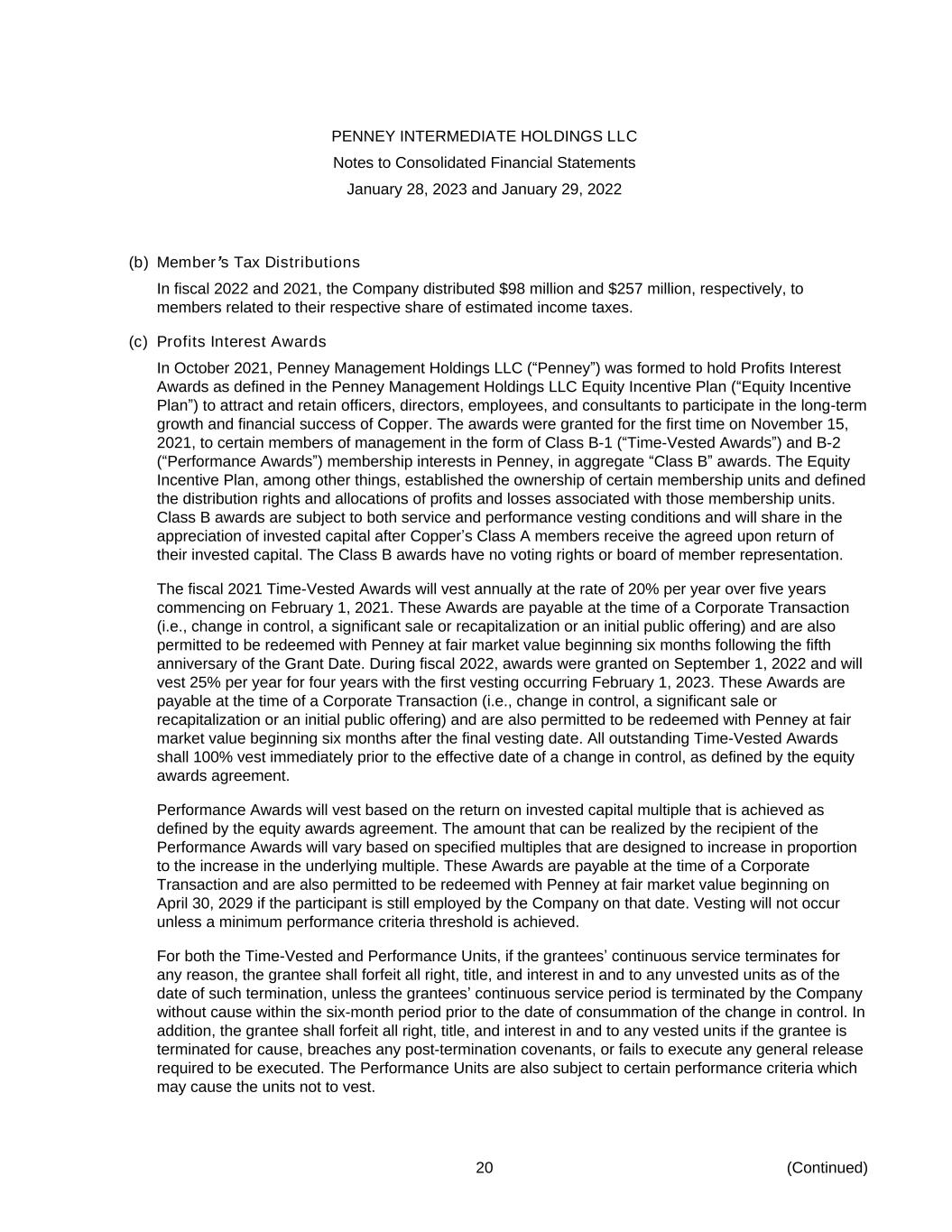
PENNEY INTERMEDIATE HOLDINGS LLC Notes to Consolidated Financial Statements January 28, 2023 and January 29, 2022 20 (Continued) (b) Member’s Tax Distributions In fiscal 2022 and 2021, the Company distributed $98 million and $257 million, respectively, to members related to their respective share of estimated income taxes. (c) Profits Interest Awards In October 2021, Penney Management Holdings LLC (“Penney”) was formed to hold Profits Interest Awards as defined in the Penney Management Holdings LLC Equity Incentive Plan (“Equity Incentive Plan”) to attract and retain officers, directors, employees, and consultants to participate in the long-term growth and financial success of Copper. The awards were granted for the first time on November 15, 2021, to certain members of management in the form of Class B-1 (“Time-Vested Awards”) and B-2 (“Performance Awards”) membership interests in Penney, in aggregate “Class B” awards. The Equity Incentive Plan, among other things, established the ownership of certain membership units and defined the distribution rights and allocations of profits and losses associated with those membership units. Class B awards are subject to both service and performance vesting conditions and will share in the appreciation of invested capital after Copper’s Class A members receive the agreed upon return of their invested capital. The Class B awards have no voting rights or board of member representation. The fiscal 2021 Time-Vested Awards will vest annually at the rate of 20% per year over five years commencing on February 1, 2021. These Awards are payable at the time of a Corporate Transaction (i.e., change in control, a significant sale or recapitalization or an initial public offering) and are also permitted to be redeemed with Penney at fair market value beginning six months following the fifth anniversary of the Grant Date. During fiscal 2022, awards were granted on September 1, 2022 and will vest 25% per year for four years with the first vesting occurring February 1, 2023. These Awards are payable at the time of a Corporate Transaction (i.e., change in control, a significant sale or recapitalization or an initial public offering) and are also permitted to be redeemed with Penney at fair market value beginning six months after the final vesting date. All outstanding Time-Vested Awards shall 100% vest immediately prior to the effective date of a change in control, as defined by the equity awards agreement. Performance Awards will vest based on the return on invested capital multiple that is achieved as defined by the equity awards agreement. The amount that can be realized by the recipient of the Performance Awards will vary based on specified multiples that are designed to increase in proportion to the increase in the underlying multiple. These Awards are payable at the time of a Corporate Transaction and are also permitted to be redeemed with Penney at fair market value beginning on April 30, 2029 if the participant is still employed by the Company on that date. Vesting will not occur unless a minimum performance criteria threshold is achieved. For both the Time-Vested and Performance Units, if the grantees’ continuous service terminates for any reason, the grantee shall forfeit all right, title, and interest in and to any unvested units as of the date of such termination, unless the grantees’ continuous service period is terminated by the Company without cause within the six-month period prior to the date of consummation of the change in control. In addition, the grantee shall forfeit all right, title, and interest in and to any vested units if the grantee is terminated for cause, breaches any post-termination covenants, or fails to execute any general release required to be executed. The Performance Units are also subject to certain performance criteria which may cause the units not to vest.
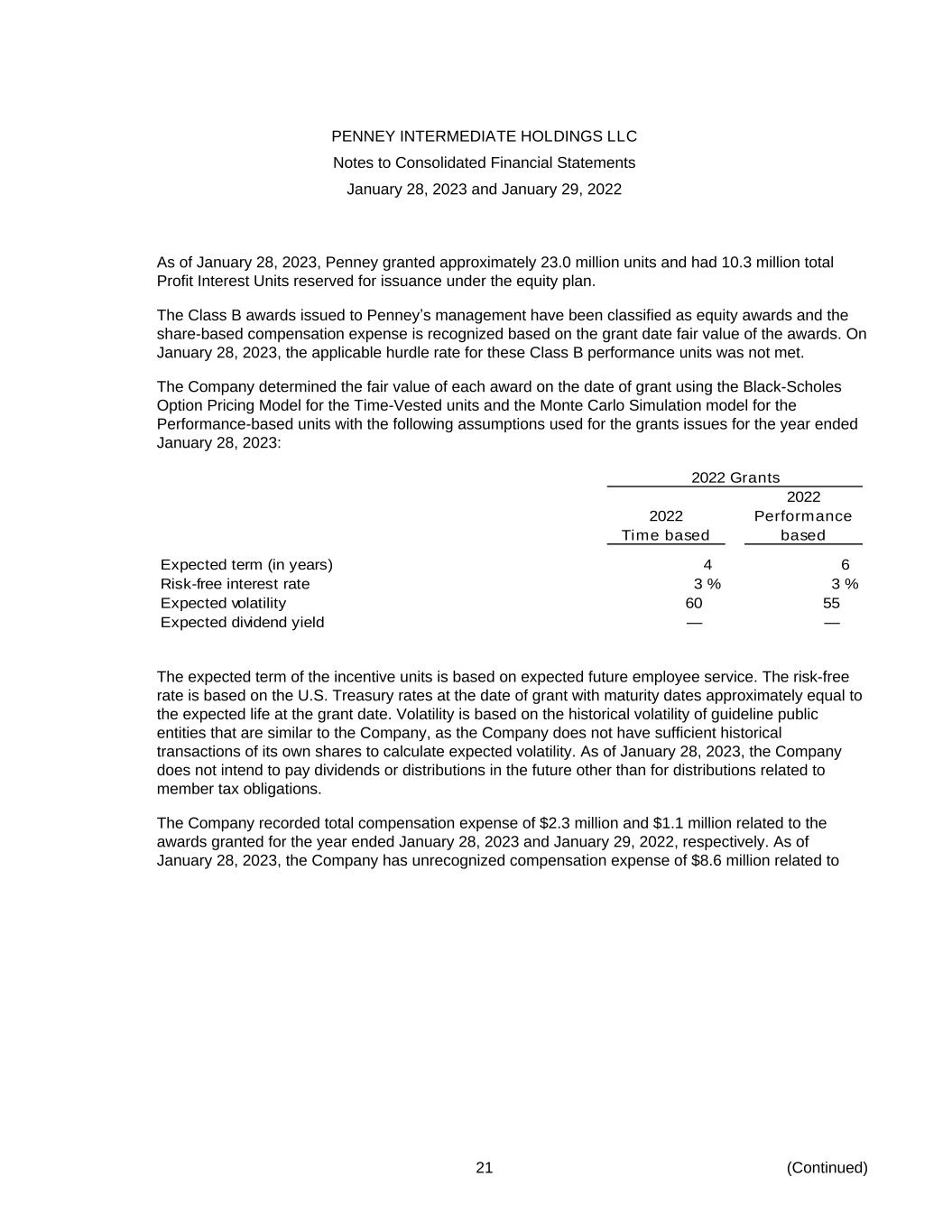
PENNEY INTERMEDIATE HOLDINGS LLC Notes to Consolidated Financial Statements January 28, 2023 and January 29, 2022 21 (Continued) As of January 28, 2023, Penney granted approximately 23.0 million units and had 10.3 million total Profit Interest Units reserved for issuance under the equity plan. The Class B awards issued to Penney’s management have been classified as equity awards and the share-based compensation expense is recognized based on the grant date fair value of the awards. On January 28, 2023, the applicable hurdle rate for these Class B performance units was not met. The Company determined the fair value of each award on the date of grant using the Black-Scholes Option Pricing Model for the Time-Vested units and the Monte Carlo Simulation model for the Performance-based units with the following assumptions used for the grants issues for the year ended January 28, 2023: 2022 Grants 2022 2022 Performance Time based based Expected term (in years) 4 6 Risk-free interest rate 3 % 3 % Expected volatility 60 55 Expected dividend yield — — The expected term of the incentive units is based on expected future employee service. The risk-free rate is based on the U.S. Treasury rates at the date of grant with maturity dates approximately equal to the expected life at the grant date. Volatility is based on the historical volatility of guideline public entities that are similar to the Company, as the Company does not have sufficient historical transactions of its own shares to calculate expected volatility. As of January 28, 2023, the Company does not intend to pay dividends or distributions in the future other than for distributions related to member tax obligations. The Company recorded total compensation expense of $2.3 million and $1.1 million related to the awards granted for the year ended January 28, 2023 and January 29, 2022, respectively. As of January 28, 2023, the Company has unrecognized compensation expense of $8.6 million related to
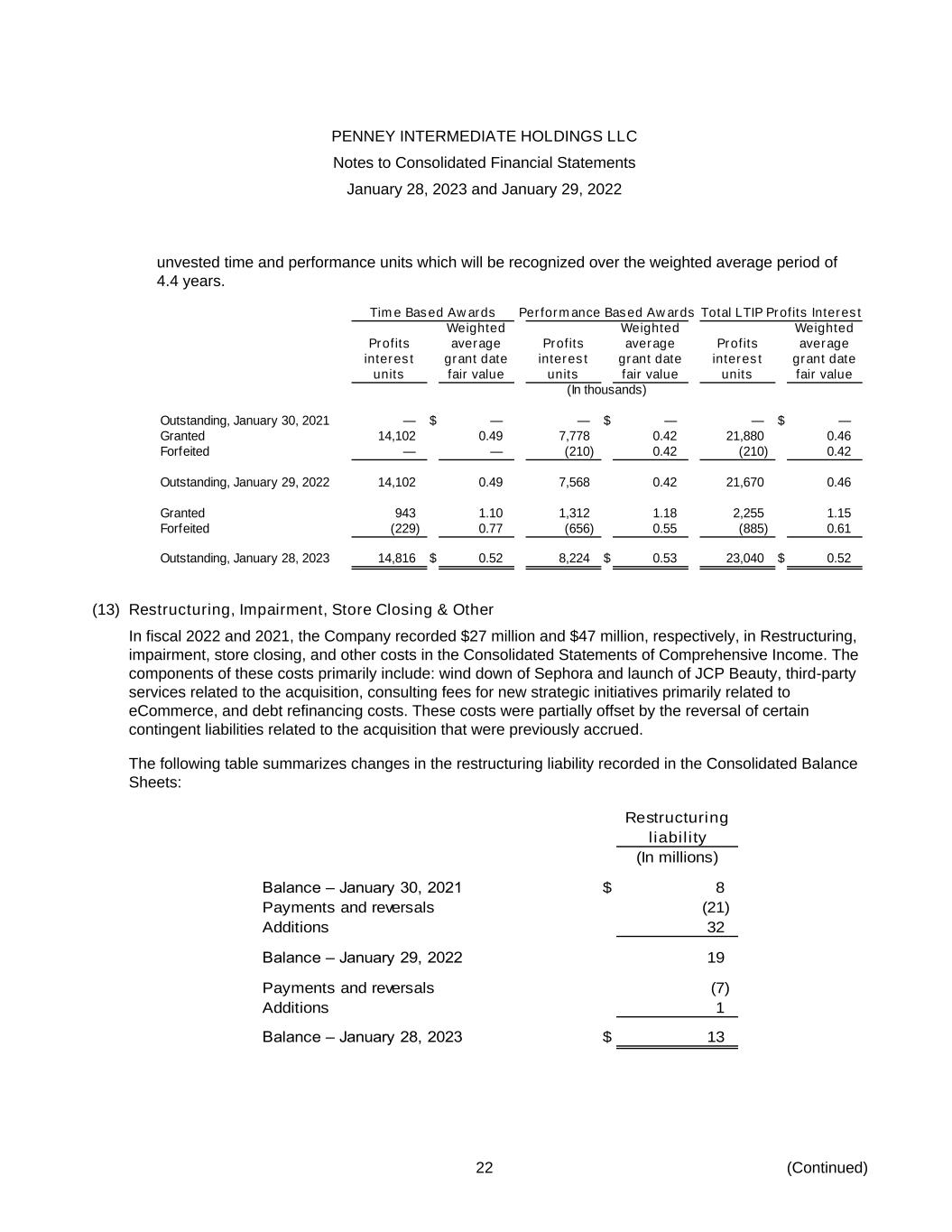
PENNEY INTERMEDIATE HOLDINGS LLC Notes to Consolidated Financial Statements January 28, 2023 and January 29, 2022 22 (Continued) unvested time and performance units which will be recognized over the weighted average period of 4.4 years. Time Based Awards Performance Based Awards Total LTIP Profits Interest Weighted Weighted Weighted Profits average Profits average Profits average interest grant date interest grant date interest grant date units fair value units fair value units fair value (In thousands) Outstanding, January 30, 2021 — $ — — $ — — $ — Granted 14,102 0.49 7,778 0.42 21,880 0.46 Forfeited — — (210) 0.42 (210) 0.42 Outstanding, January 29, 2022 14,102 0.49 7,568 0.42 21,670 0.46 Granted 943 1.10 1,312 1.18 2,255 1.15 Forfeited (229) 0.77 (656) 0.55 (885) 0.61 Outstanding, January 28, 2023 14,816 $ 0.52 8,224 $ 0.53 23,040 $ 0.52 (13) Restructuring, Impairment, Store Closing & Other In fiscal 2022 and 2021, the Company recorded $27 million and $47 million, respectively, in Restructuring, impairment, store closing, and other costs in the Consolidated Statements of Comprehensive Income. The components of these costs primarily include: wind down of Sephora and launch of JCP Beauty, third-party services related to the acquisition, consulting fees for new strategic initiatives primarily related to eCommerce, and debt refinancing costs. These costs were partially offset by the reversal of certain contingent liabilities related to the acquisition that were previously accrued. The following table summarizes changes in the restructuring liability recorded in the Consolidated Balance Sheets: Restructuring liability (In millions) Balance – January 30, 2021 $ 8 Payments and reversals (21) Additions 32 Balance – January 29, 2022 19 Payments and reversals (7) Additions 1 Balance – January 28, 2023 $ 13
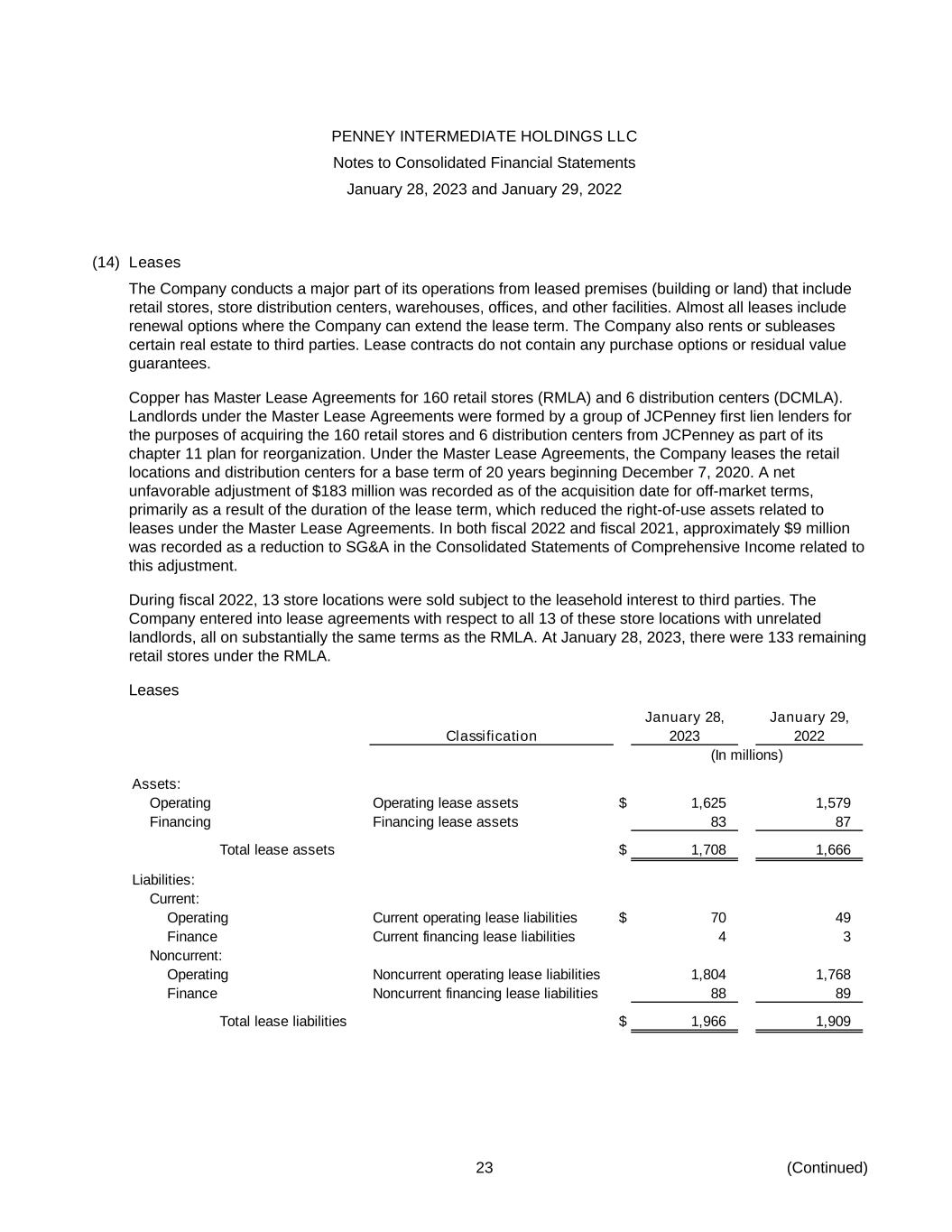
PENNEY INTERMEDIATE HOLDINGS LLC Notes to Consolidated Financial Statements January 28, 2023 and January 29, 2022 23 (Continued) (14) Leases The Company conducts a major part of its operations from leased premises (building or land) that include retail stores, store distribution centers, warehouses, offices, and other facilities. Almost all leases include renewal options where the Company can extend the lease term. The Company also rents or subleases certain real estate to third parties. Lease contracts do not contain any purchase options or residual value guarantees. Copper has Master Lease Agreements for 160 retail stores (RMLA) and 6 distribution centers (DCMLA). Landlords under the Master Lease Agreements were formed by a group of JCPenney first lien lenders for the purposes of acquiring the 160 retail stores and 6 distribution centers from JCPenney as part of its chapter 11 plan for reorganization. Under the Master Lease Agreements, the Company leases the retail locations and distribution centers for a base term of 20 years beginning December 7, 2020. A net unfavorable adjustment of $183 million was recorded as of the acquisition date for off-market terms, primarily as a result of the duration of the lease term, which reduced the right-of-use assets related to leases under the Master Lease Agreements. In both fiscal 2022 and fiscal 2021, approximately $9 million was recorded as a reduction to SG&A in the Consolidated Statements of Comprehensive Income related to this adjustment. During fiscal 2022, 13 store locations were sold subject to the leasehold interest to third parties. The Company entered into lease agreements with respect to all 13 of these store locations with unrelated landlords, all on substantially the same terms as the RMLA. At January 28, 2023, there were 133 remaining retail stores under the RMLA. Leases January 28, January 29, Classification 2023 2022 (In millions) Assets: Operating Operating lease assets $ 1,625 1,579 Financing Financing lease assets 83 87 Total lease assets $ 1,708 1,666 Liabilities: Current: Operating Current operating lease liabilities $ 70 49 Finance Current financing lease liabilities 4 3 Noncurrent: Operating Noncurrent operating lease liabilities 1,804 1,768 Finance Noncurrent financing lease liabilities 88 89 Total lease liabilities $ 1,966 1,909
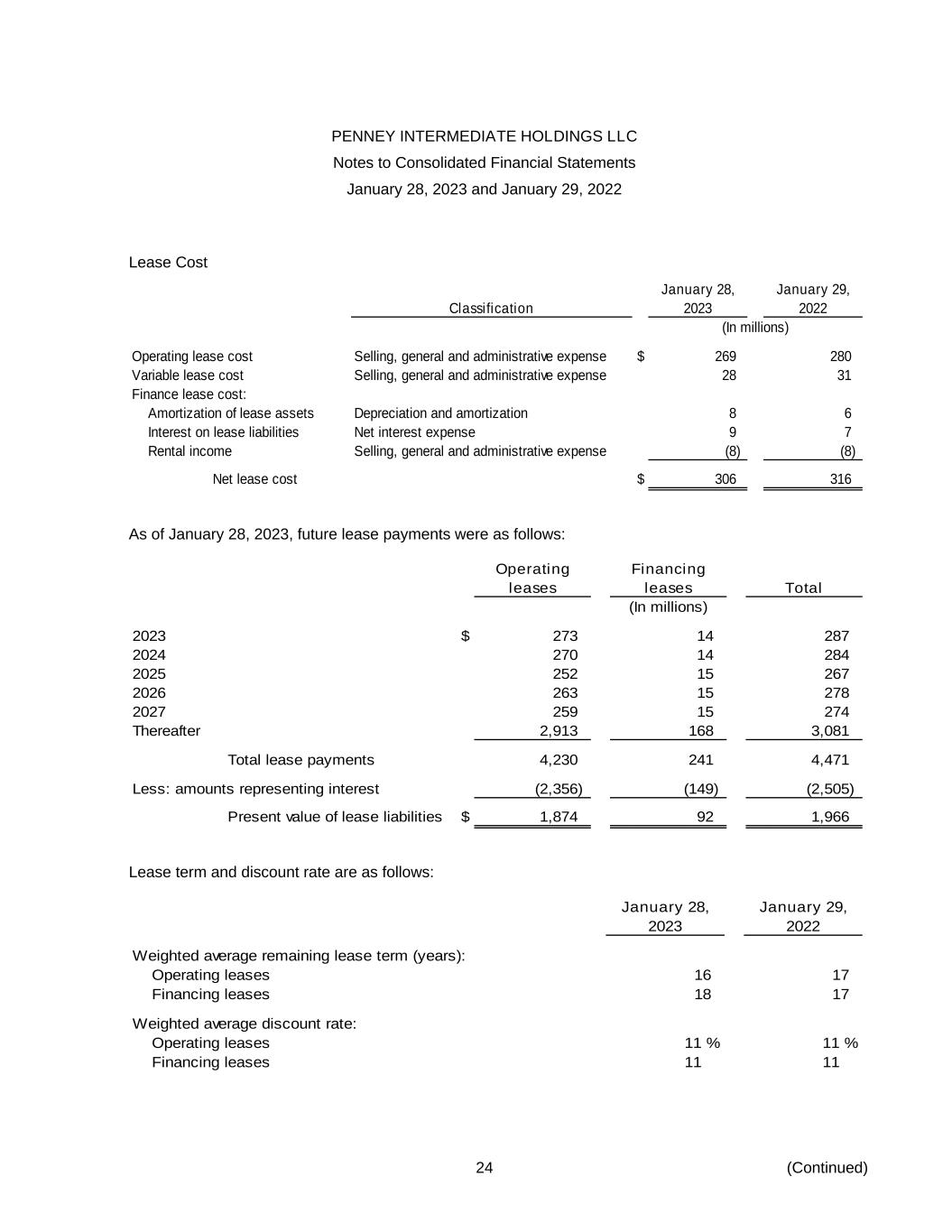
PENNEY INTERMEDIATE HOLDINGS LLC Notes to Consolidated Financial Statements January 28, 2023 and January 29, 2022 24 (Continued) Lease Cost January 28, January 29, Classification 2023 2022 (In millions) Operating lease cost Selling, general and administrative expense $ 269 280 Variable lease cost Selling, general and administrative expense 28 31 Finance lease cost: Amortization of lease assets Depreciation and amortization 8 6 Interest on lease liabilities Net interest expense 9 7 Rental income Selling, general and administrative expense (8) (8) Net lease cost $ 306 316 As of January 28, 2023, future lease payments were as follows: Operating Financing leases leases Total (In millions) 2023 $ 273 14 287 2024 270 14 284 2025 252 15 267 2026 263 15 278 2027 259 15 274 Thereafter 2,913 168 3,081 Total lease payments 4,230 241 4,471 Less: amounts representing interest (2,356) (149) (2,505) Present value of lease liabilities $ 1,874 92 1,966 Lease term and discount rate are as follows: January 28, January 29, 2023 2022 Weighted average remaining lease term (years): Operating leases 16 17 Financing leases 18 17 Weighted average discount rate: Operating leases 11 % 11 % Financing leases 11 11
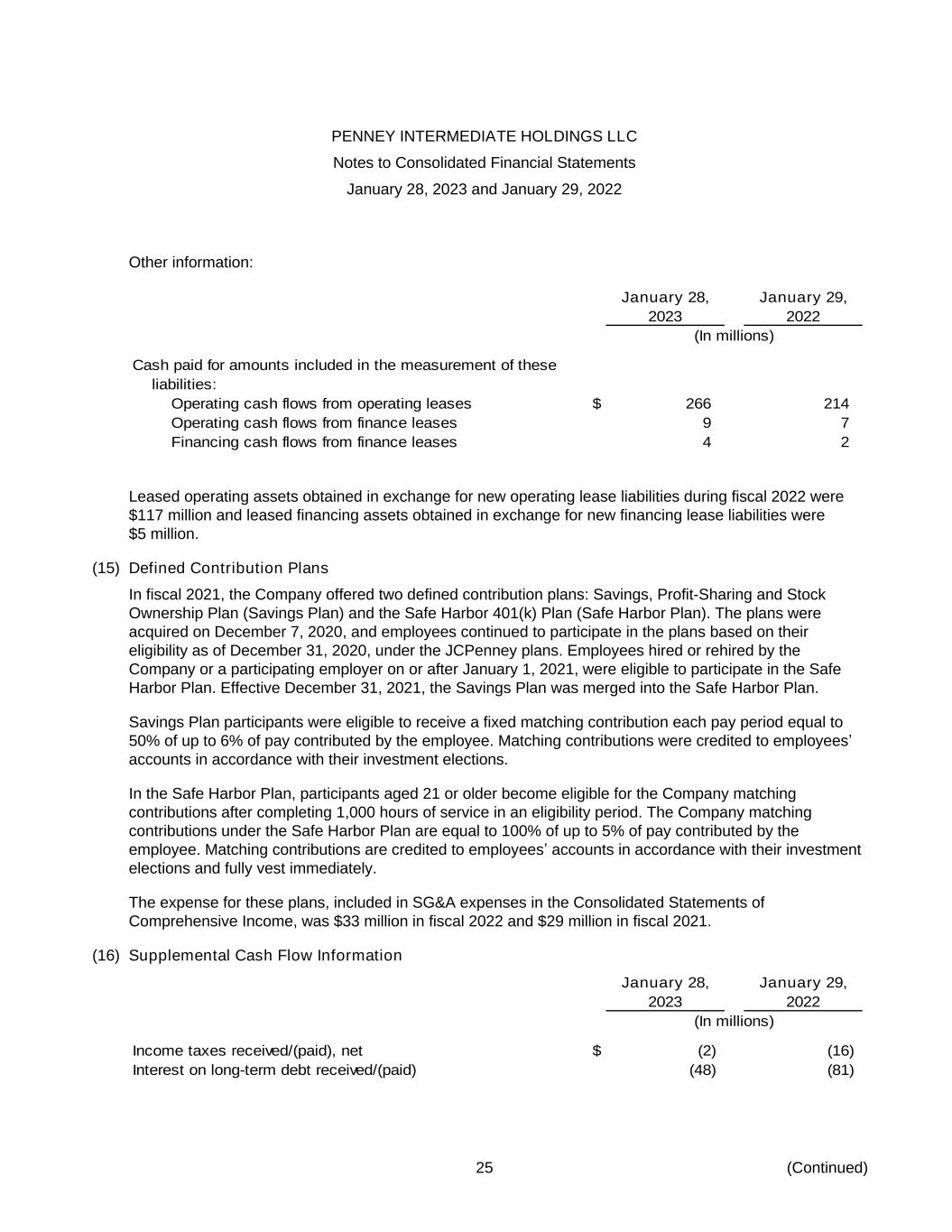
PENNEY INTERMEDIATE HOLDINGS LLC Notes to Consolidated Financial Statements January 28, 2023 and January 29, 2022 25 (Continued) Other information: January 28, January 29, 2023 2022 (In millions) Cash paid for amounts included in the measurement of these liabilities: Operating cash flows from operating leases $ 266 214 Operating cash flows from finance leases 9 7 Financing cash flows from finance leases 4 2 Leased operating assets obtained in exchange for new operating lease liabilities during fiscal 2022 were $117 million and leased financing assets obtained in exchange for new financing lease liabilities were $5 million. (15) Defined Contribution Plans In fiscal 2021, the Company offered two defined contribution plans: Savings, Profit-Sharing and Stock Ownership Plan (Savings Plan) and the Safe Harbor 401(k) Plan (Safe Harbor Plan). The plans were acquired on December 7, 2020, and employees continued to participate in the plans based on their eligibility as of December 31, 2020, under the JCPenney plans. Employees hired or rehired by the Company or a participating employer on or after January 1, 2021, were eligible to participate in the Safe Harbor Plan. Effective December 31, 2021, the Savings Plan was merged into the Safe Harbor Plan. Savings Plan participants were eligible to receive a fixed matching contribution each pay period equal to 50% of up to 6% of pay contributed by the employee. Matching contributions were credited to employees’ accounts in accordance with their investment elections. In the Safe Harbor Plan, participants aged 21 or older become eligible for the Company matching contributions after completing 1,000 hours of service in an eligibility period. The Company matching contributions under the Safe Harbor Plan are equal to 100% of up to 5% of pay contributed by the employee. Matching contributions are credited to employees’ accounts in accordance with their investment elections and fully vest immediately. The expense for these plans, included in SG&A expenses in the Consolidated Statements of Comprehensive Income, was $33 million in fiscal 2022 and $29 million in fiscal 2021. (16) Supplemental Cash Flow Information January 28, January 29, 2023 2022 (In millions) Income taxes received/(paid), net $ (2) (16) Interest on long-term debt received/(paid) (48) (81)
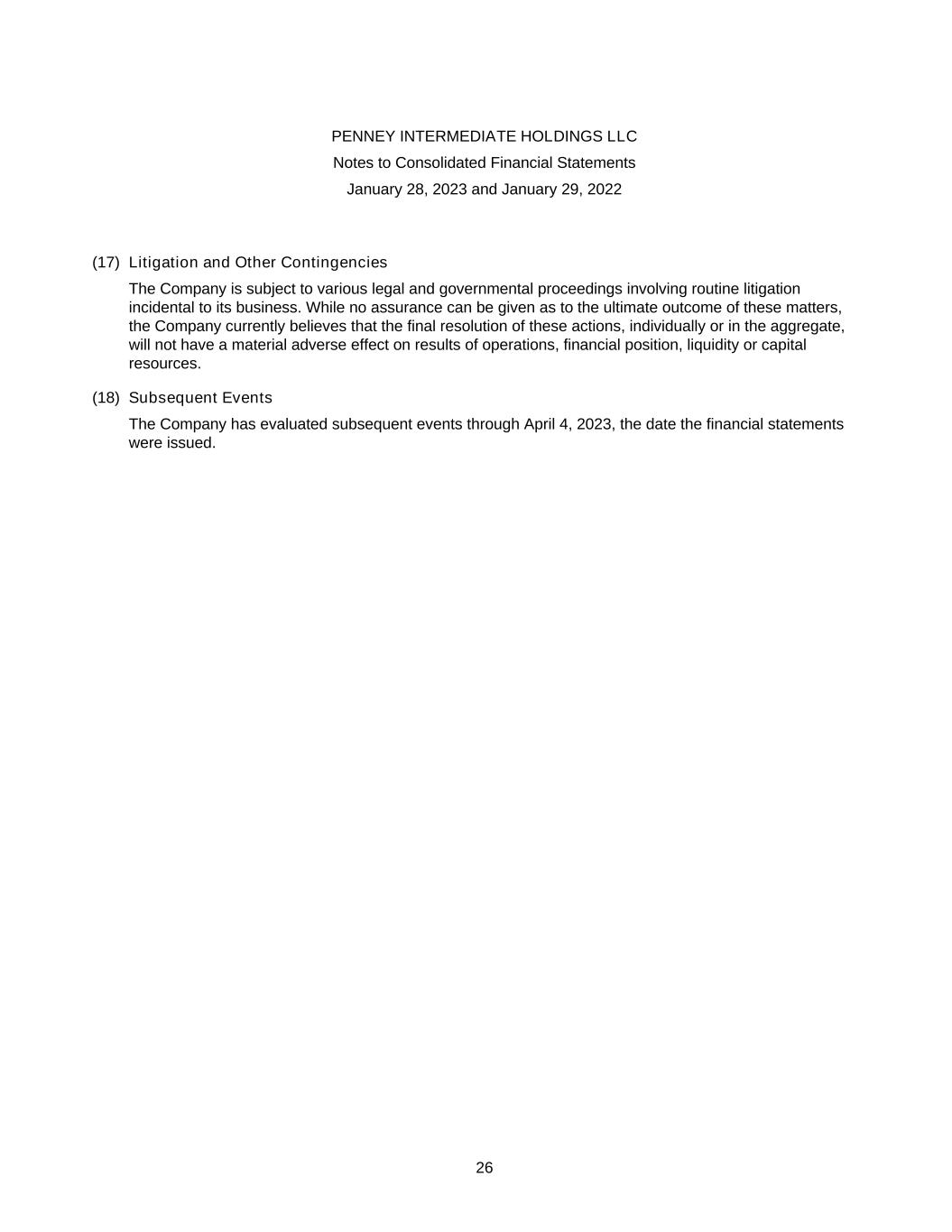
PENNEY INTERMEDIATE HOLDINGS LLC Notes to Consolidated Financial Statements January 28, 2023 and January 29, 2022 26 (17) Litigation and Other Contingencies The Company is subject to various legal and governmental proceedings involving routine litigation incidental to its business. While no assurance can be given as to the ultimate outcome of these matters, the Company currently believes that the final resolution of these actions, individually or in the aggregate, will not have a material adverse effect on results of operations, financial position, liquidity or capital resources. (18) Subsequent Events The Company has evaluated subsequent events through April 4, 2023, the date the financial statements were issued.
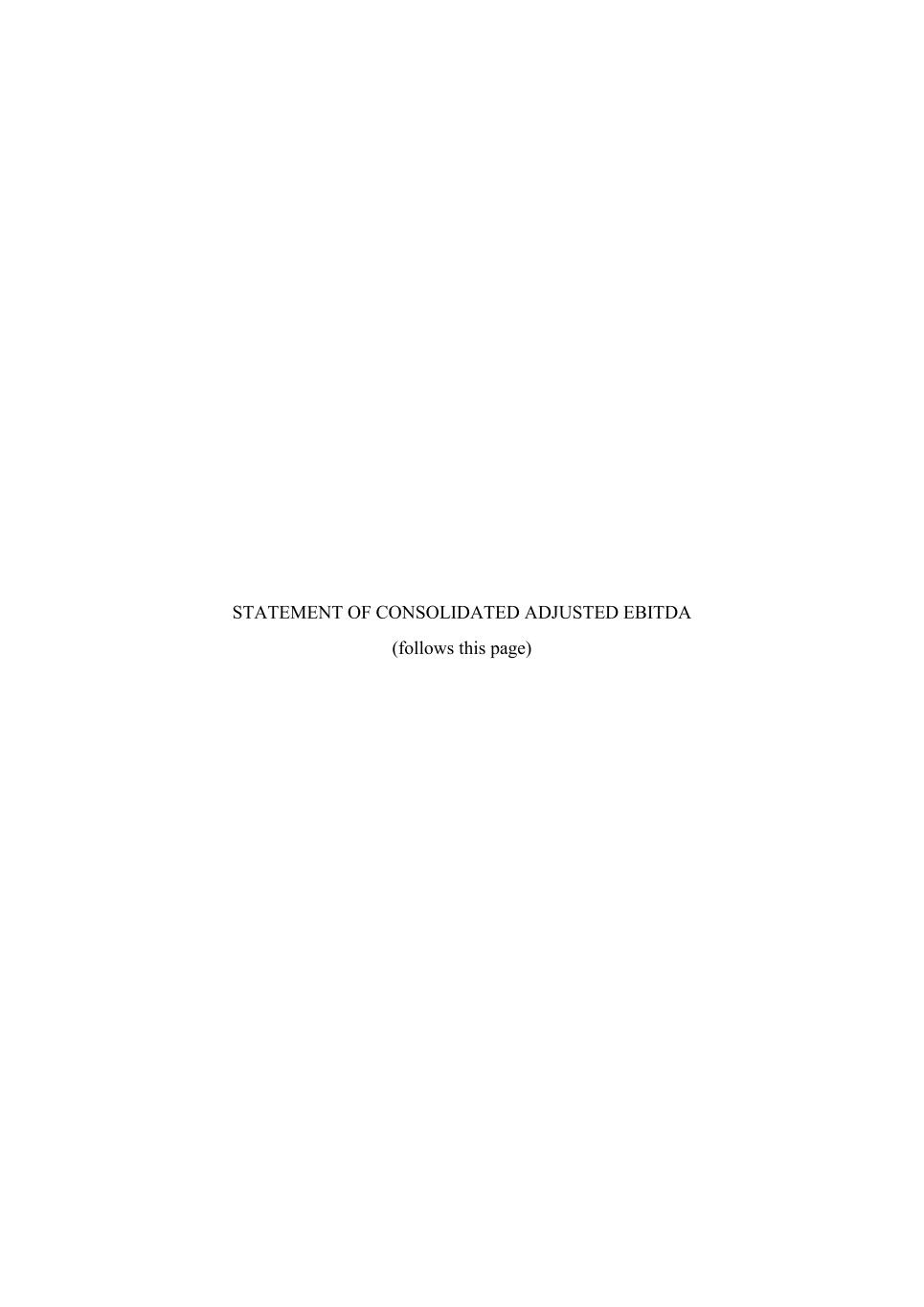
STATEMENT OF CONSOLIDATED ADJUSTED EBITDA (follows this page)
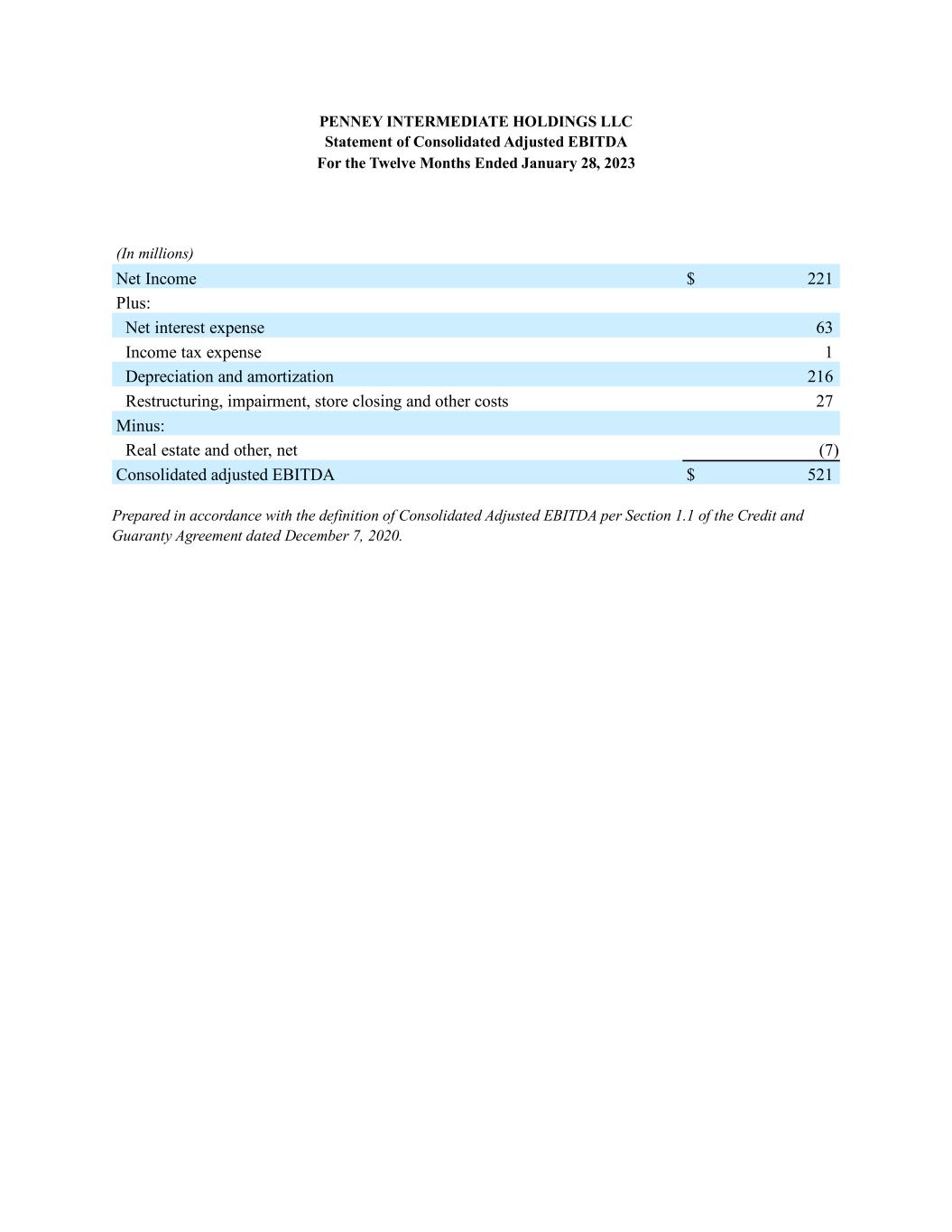
PENNEY INTERMEDIATE HOLDINGS LLC Statement of Consolidated Adjusted EBITDA For the Twelve Months Ended January 28, 2023 (In millions) Net Income $ 221 Plus: Net interest expense 63 Income tax expense 1 Depreciation and amortization 216 Restructuring, impairment, store closing and other costs 27 Minus: Real estate and other, net (7) Consolidated adjusted EBITDA $ 521 Prepared in accordance with the definition of Consolidated Adjusted EBITDA per Section 1.1 of the Credit and Guaranty Agreement dated December 7, 2020.